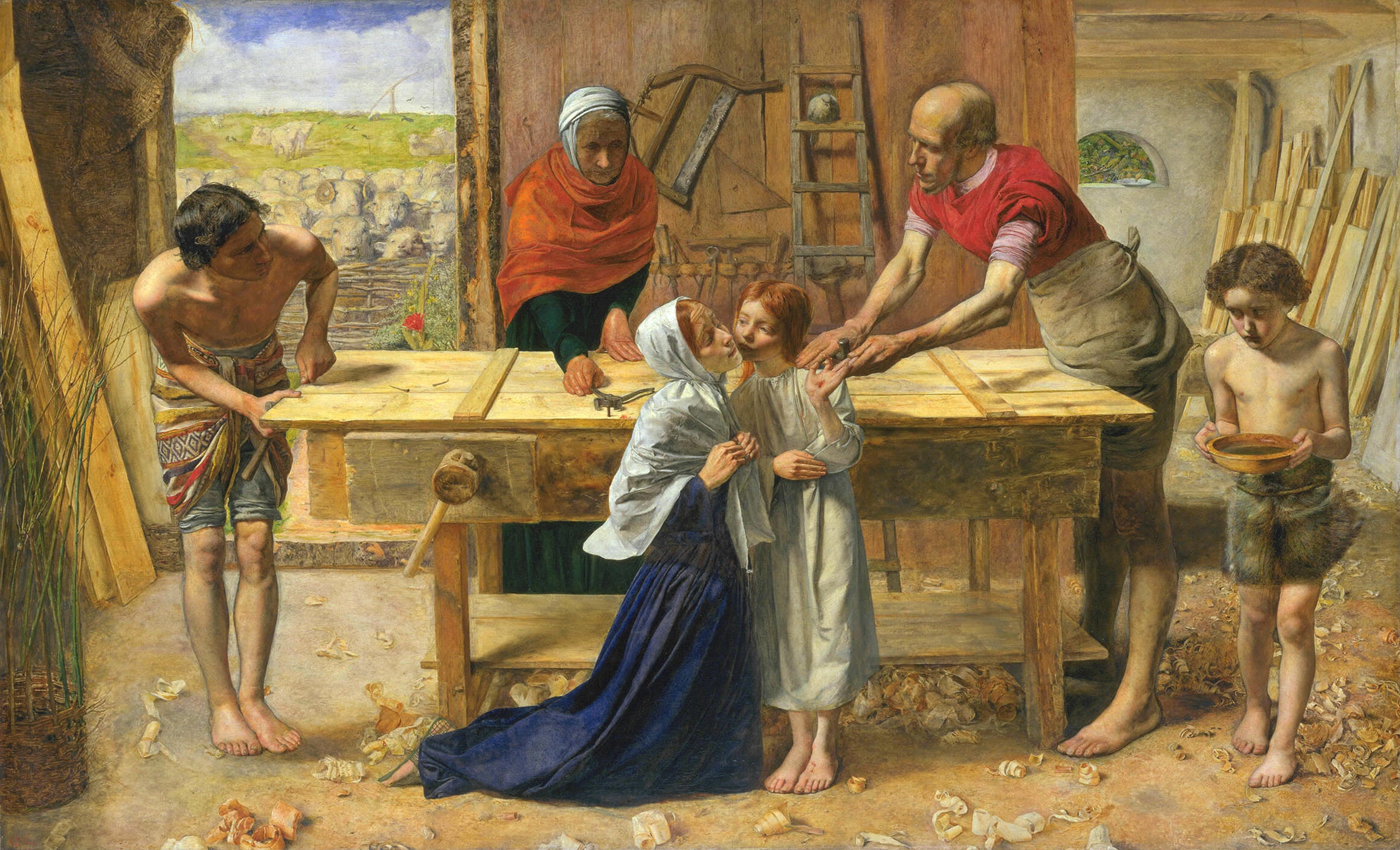Aesthetic Concepts
Taking Woman Holding a Balance as an example, we will demonstrate how to employ different aesthetic concepts to interpret artworks.

Woman Holding a Balance, 1664
Johannes Vermeer (1632 - 1675)
Oil on canvas
39.7 x 35.5 cm
National Gallery of Art, Washington, D.C.
Formalism
Introduction
- According to Bell, the shared quality of all artworks is their possession of significant form.
- The unique configurations of visual elements like colours, lines, space, and so on, are arranged by artists with awareness.
- Engaging in art appreciation and criticism, viewers should pay attention to formal expression, while dissociating the artworks from any utilitarian attributes.
- In art appreciation, viewers use their intuition to grasp the formal properties of artworks.
Application
- The white cap with ties directs viewers’ attention to the single figure of the painting.
- The diffused sunlight warmed by the orange curtain illuminates the gray wall.
- Though most of the interior is filled with shadows, the orange sunlight creates accents in the face of the young woman and the fingers of her right hand, the scales she is holding, as well as the right rim of the picture frame.
- A diagonal line is formed by the Last Judgment at the top right quadrant of the painting and the table occupied the bottom left quadrant with jewellery lying on it.
- The small finger of the young woman’s right hand establishes an echo to the horizontal bar of the balance, creating a pair of parallel lines.
- The painting of the Last Judgment hanging on the wall appears in a murky and yellowish tone, forming a dark rectangular shape.
The white cap with ties directs viewers’ attention to the single figure of the painting.

The diffused sunlight warmed by the orange curtain illuminates the gray wall.
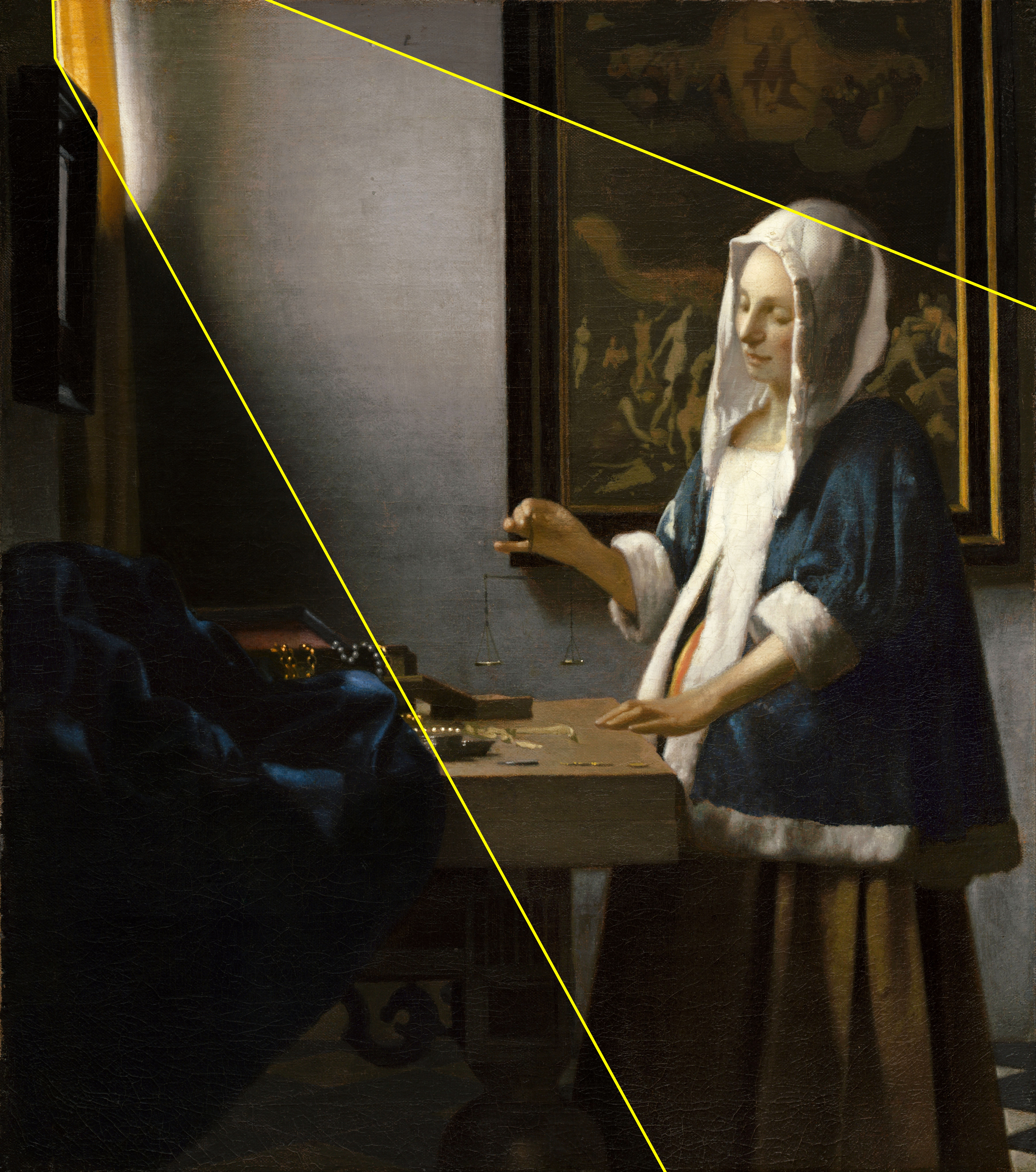
Parallel lines in the painting direct viewers’ attention to the small finger of the young woman’s right hand.

The right hand of the young woman and the surface of the table form a pyramidal composition.

The small finger of the young woman’s right hand echoes the horizontal bar of the balance, creating a pair of parallel lines.

A diagonal line is formed by the Last Judgment at the top right quadrant of the painting and the table occupied the bottom left quadrant with jewellery lying on it.
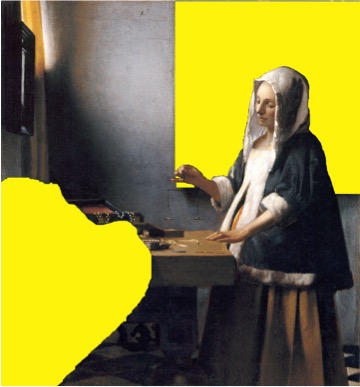
Expressionism
Introduction
- Expressivism considers art as expression of artists’ subjective imagination and feelings.
- Art employs image or form to externalize people’s inner emotional state for the purpose of catharsis and communication.
- In art appreciation, viewers catch the emotions that artists want to communicate.
Application
- Expressivism draws attention to emotions conveyed by artworks. In Vermeer’s painting, the young woman looks calm and composed while gazing at the scales held in her right hand, waiting for the delicate modulations of the balance to come to rest and equilibrium to be restored.
- The young woman is too concentrated to concern herself with the jewellery lying on the table. Her expression of quiet contemplation is suggestive of her inner peace and serenity.
The calm and composed expression of the young woman reflects her inner peace and serenity.

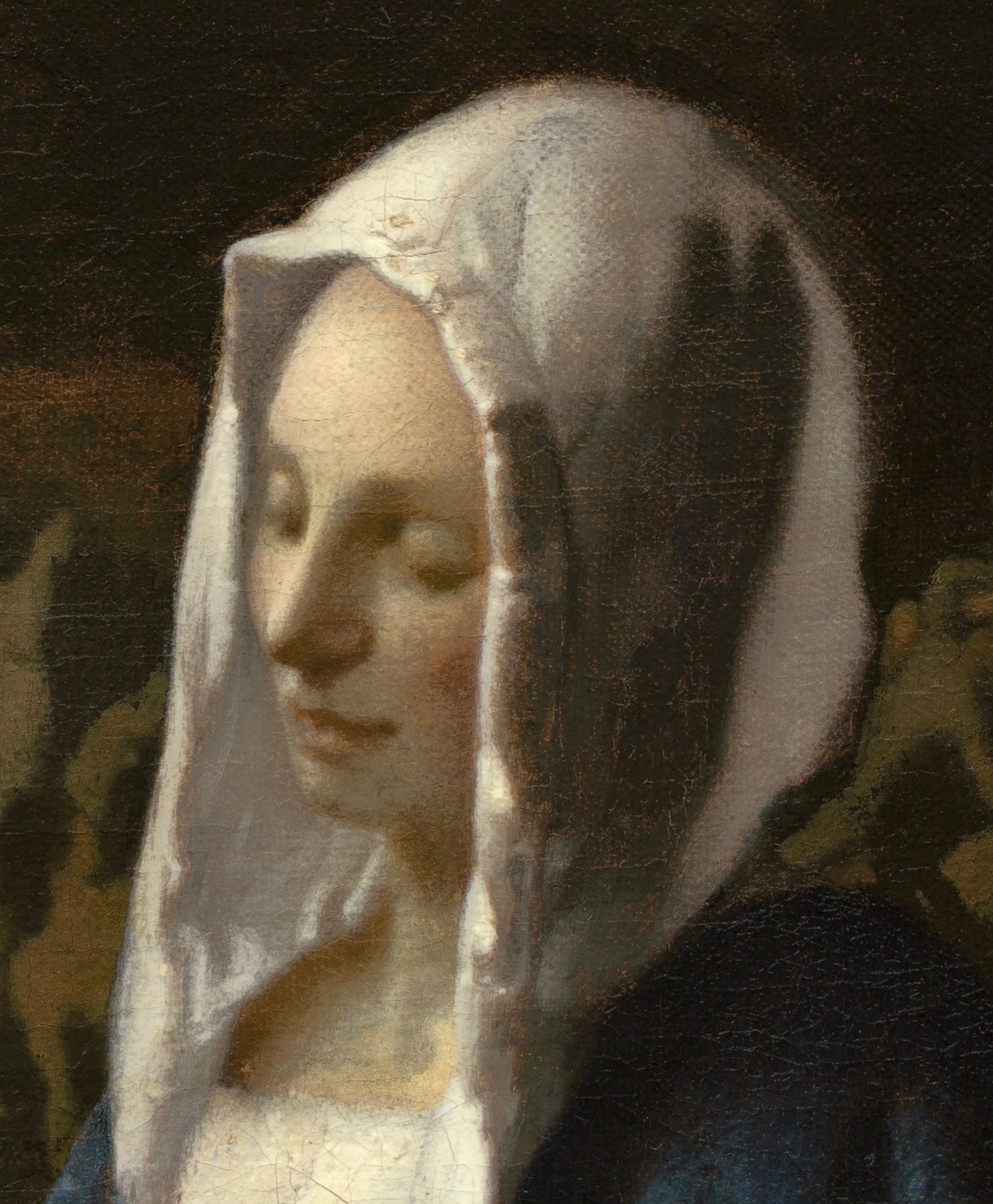
Pietà depicts the Virgin Mary, bearing the dead body of the Christ on her kneels, with an expression of sadness and lamentation on her face
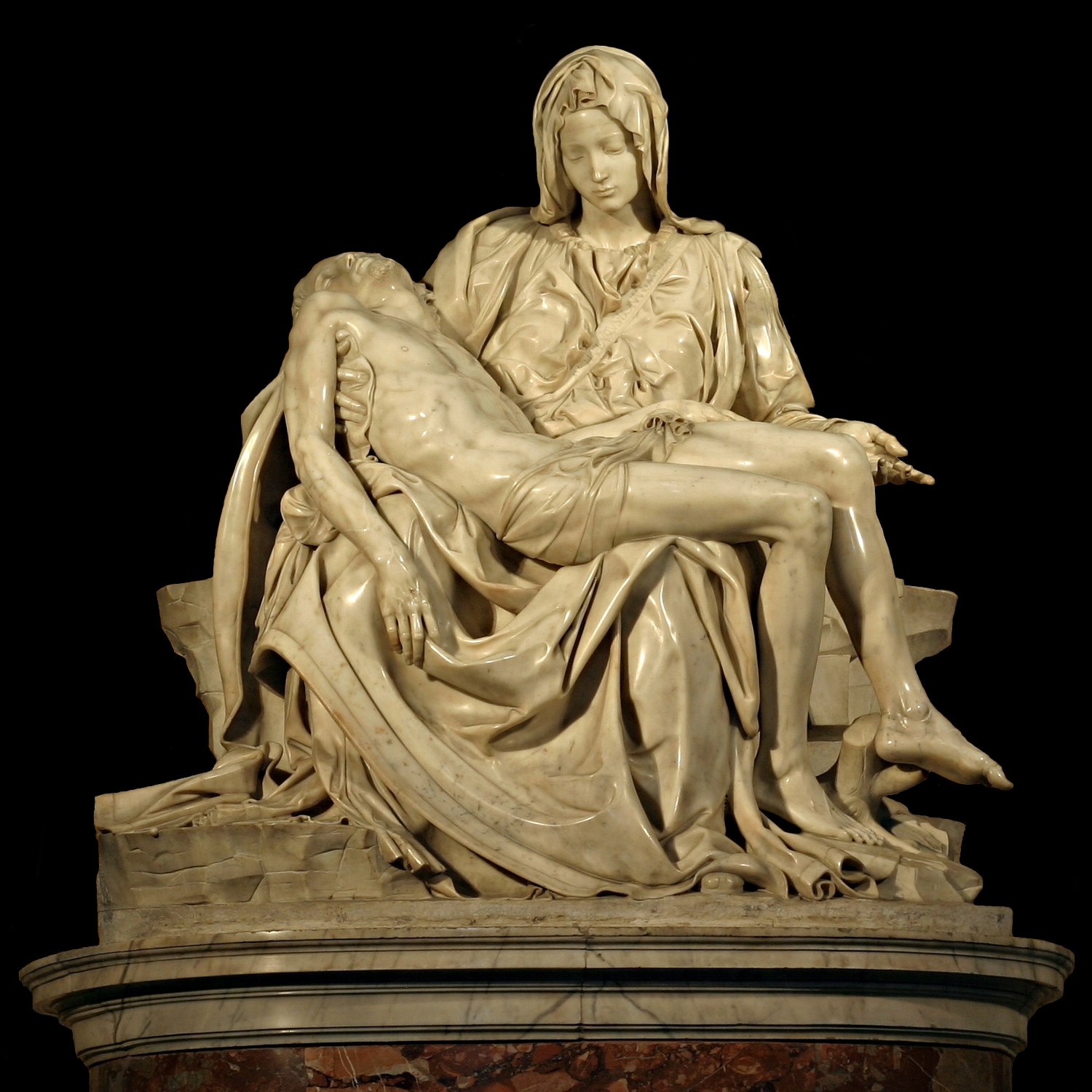
Pieta, 1498–1499
Michelangelo (1475-1564)
Marble
174 × 195 cm
St. Peter's Basilica, Vatican City
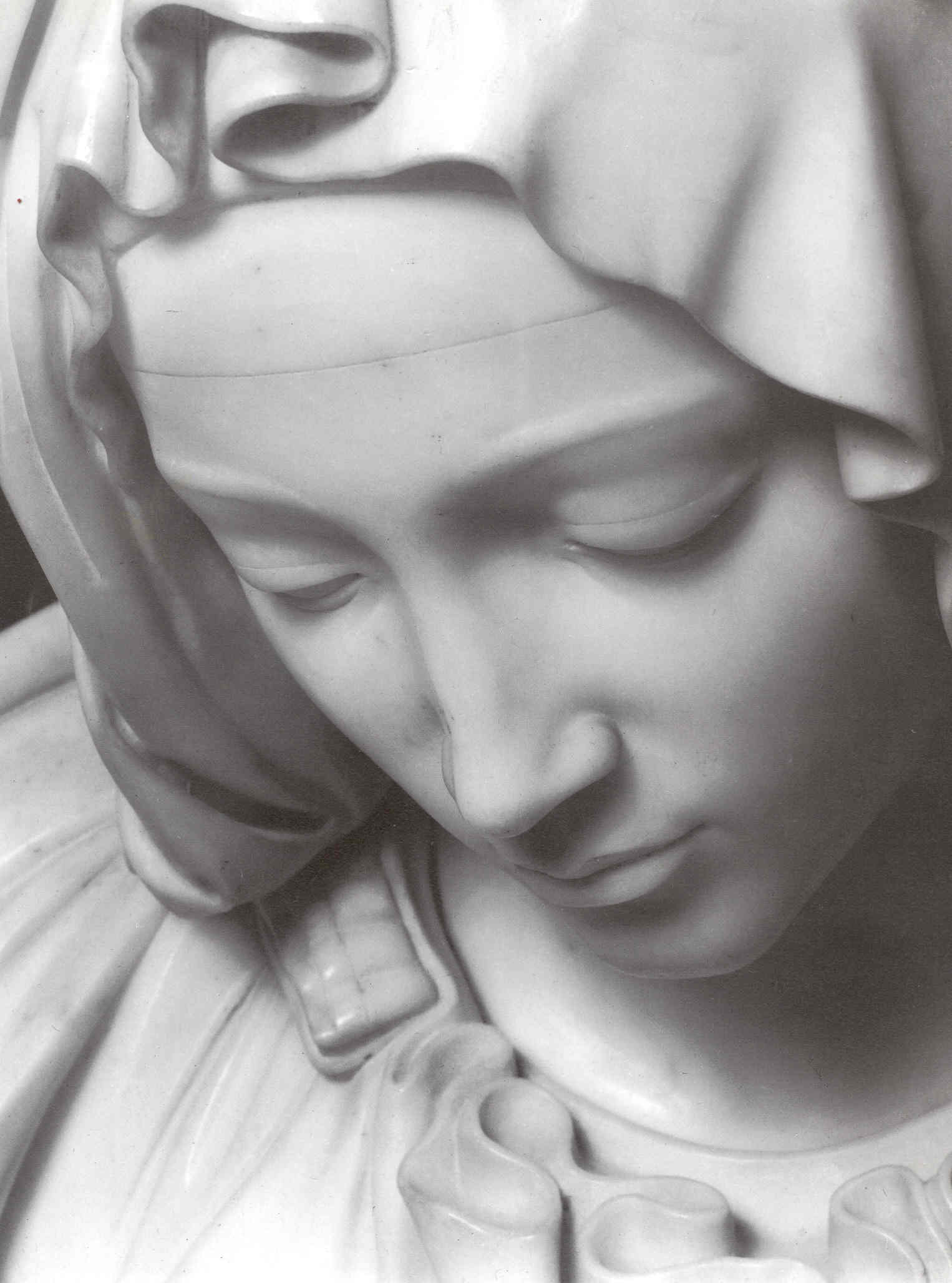
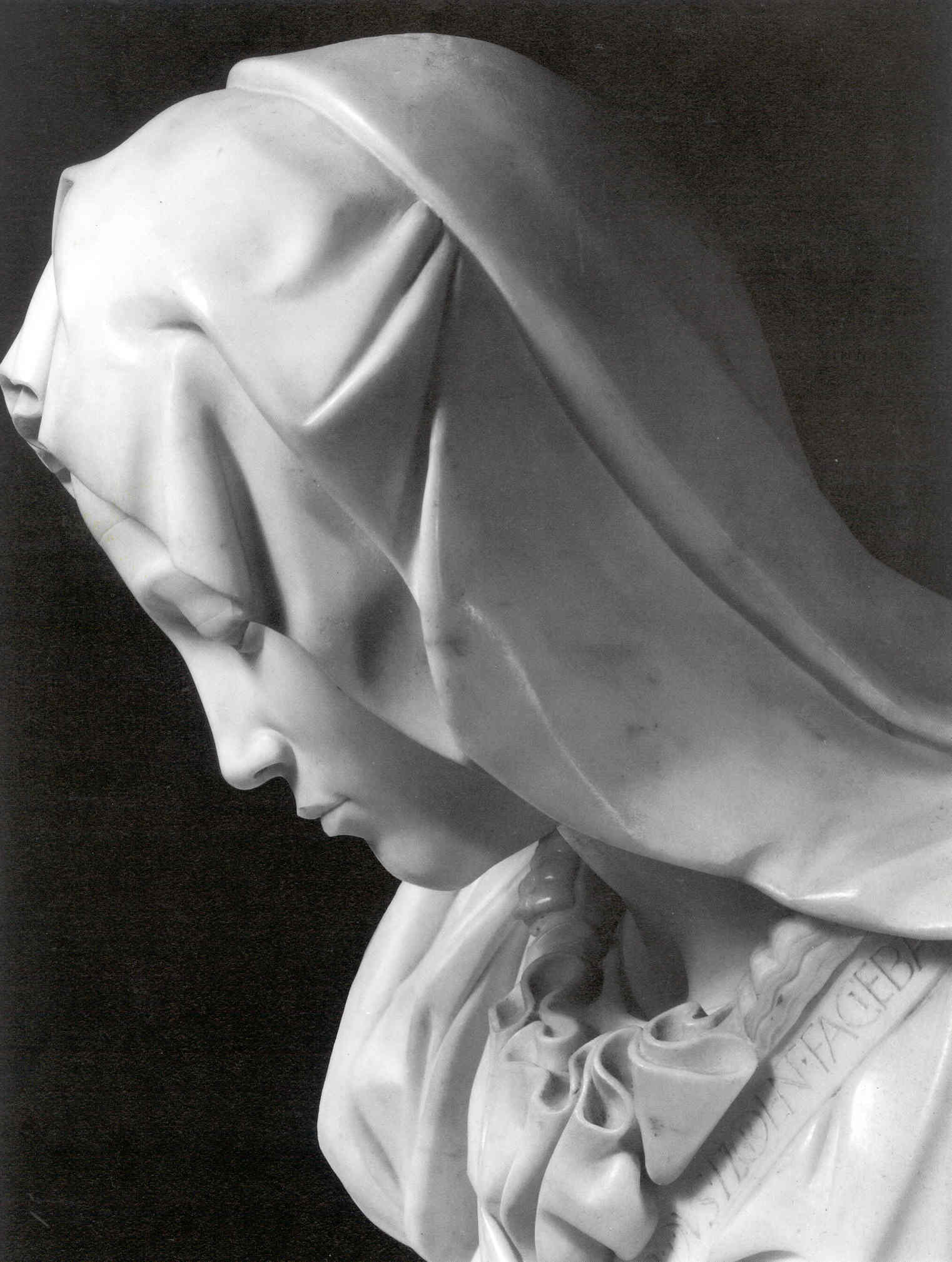
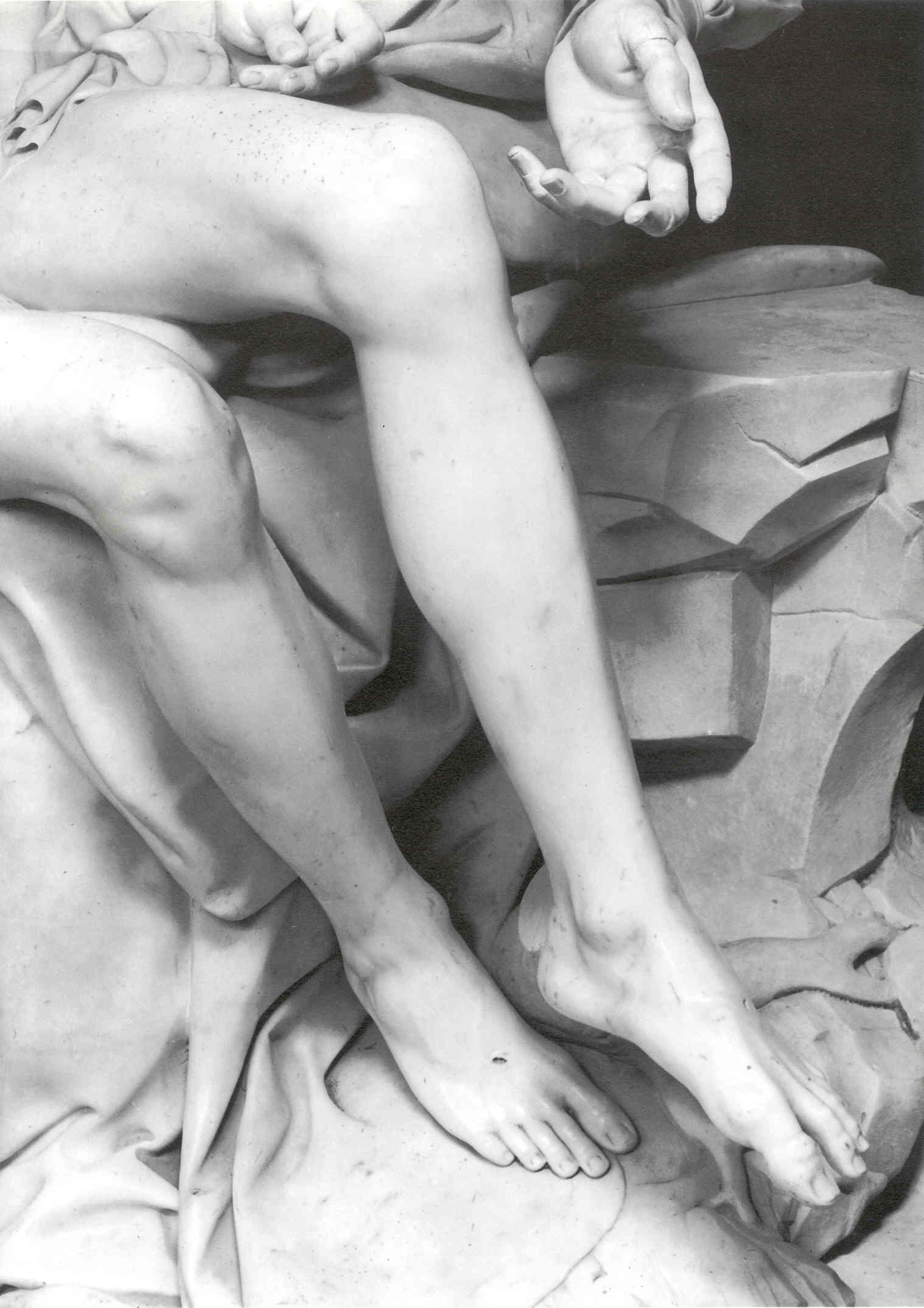
Artworks depicting tenderness of mother.
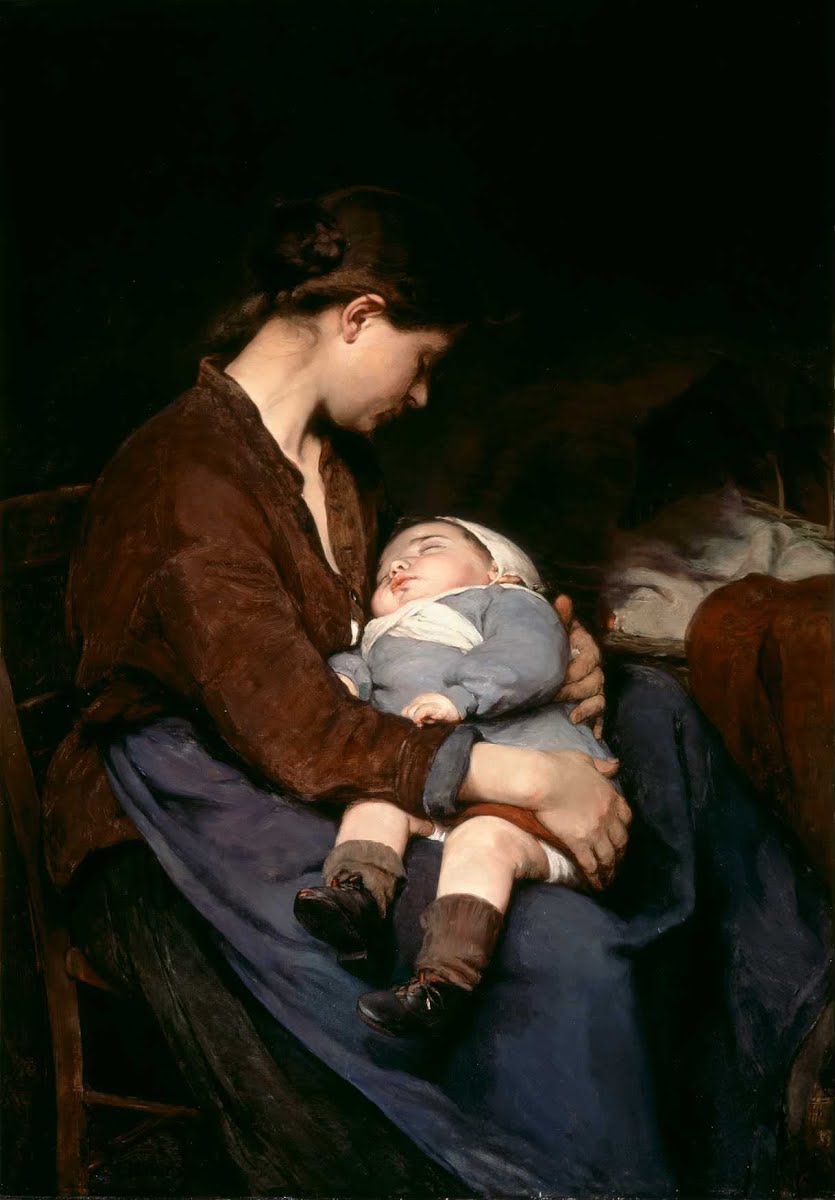
A Mother, 1888
Elizabeth Nourse (1859-1938)
Oil on canvas
115.6 x 81.3 cm
Cincinnati Art Museum
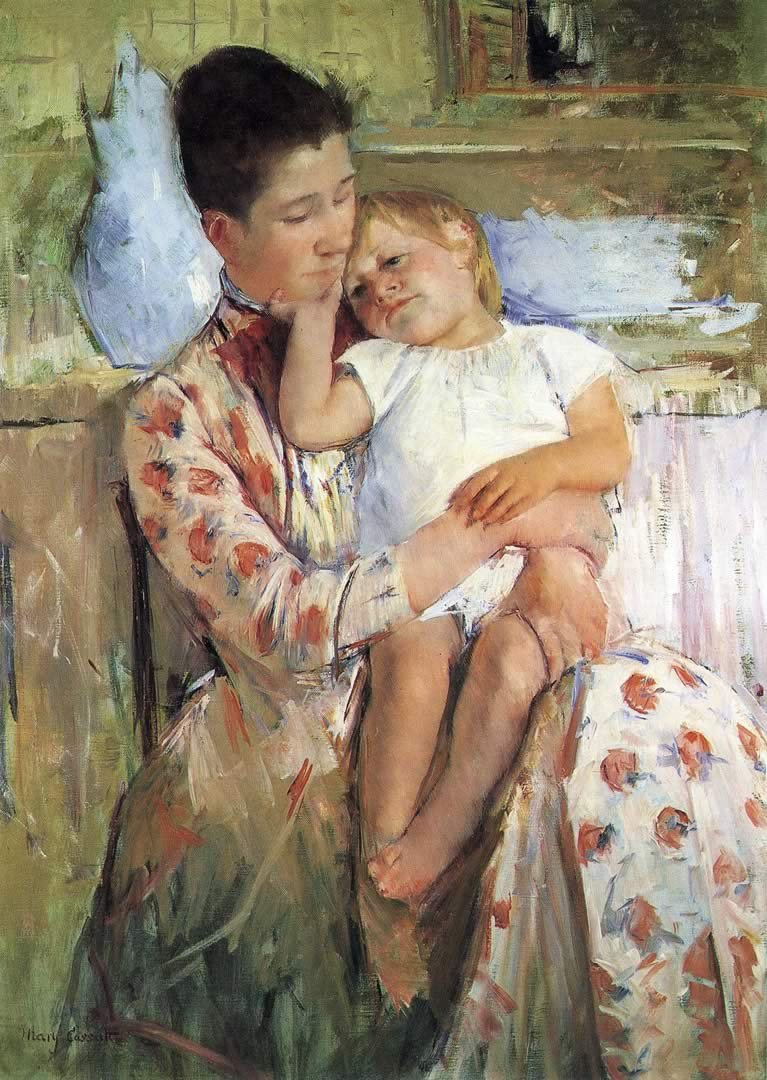
Emmie and her Child, 1889
Mary Cassatt (1844 - 1926)
88 x 65 cm
Oil on canvas
Wichita Art Museum, Wichita, US
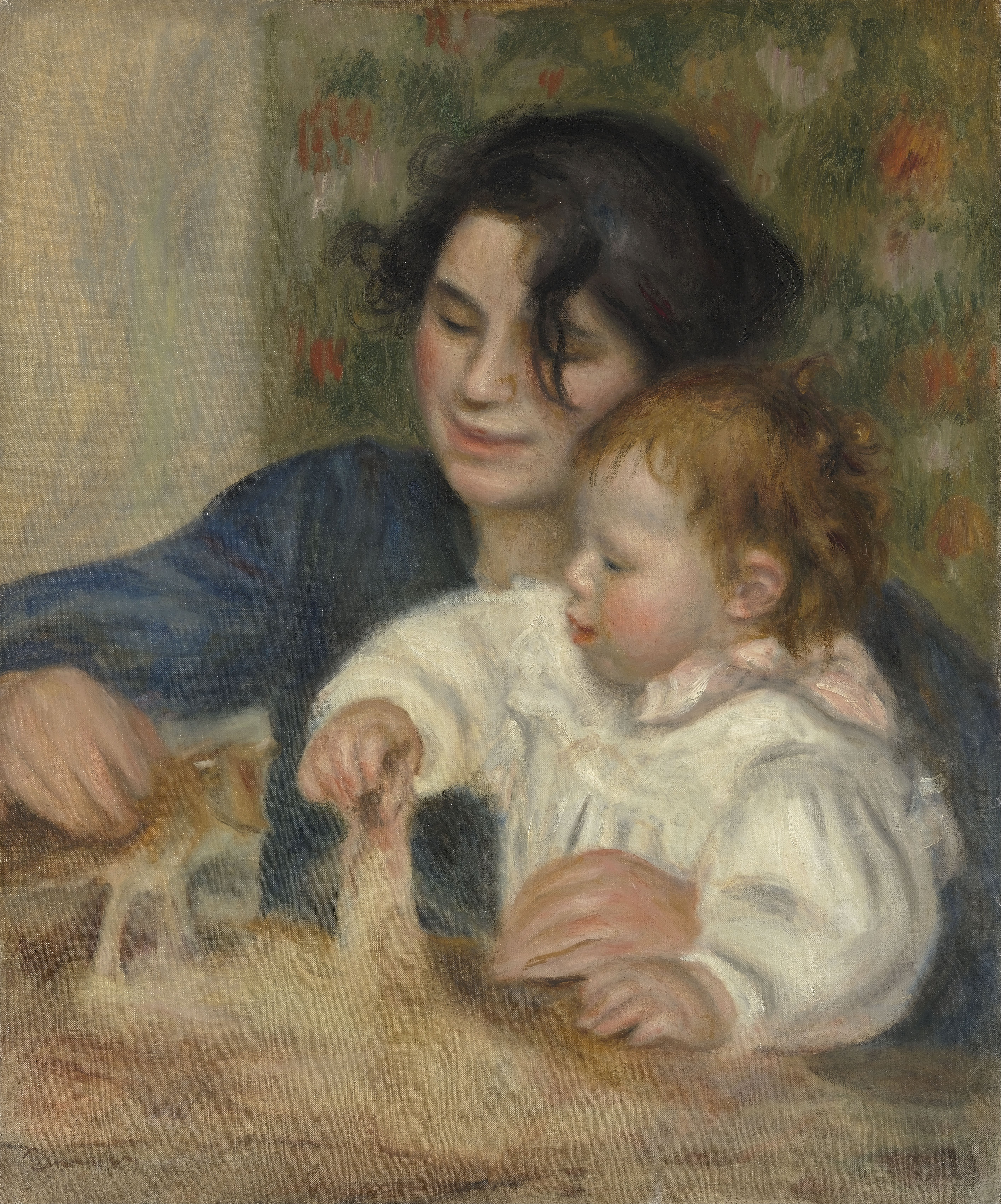
Gabrielle and Jean (1895 - 1896)
Pierre-Auguste Renoir (1841–1919)
Oil on canvas
65 x 54 cm
Musée de l'Orangerie, Paris
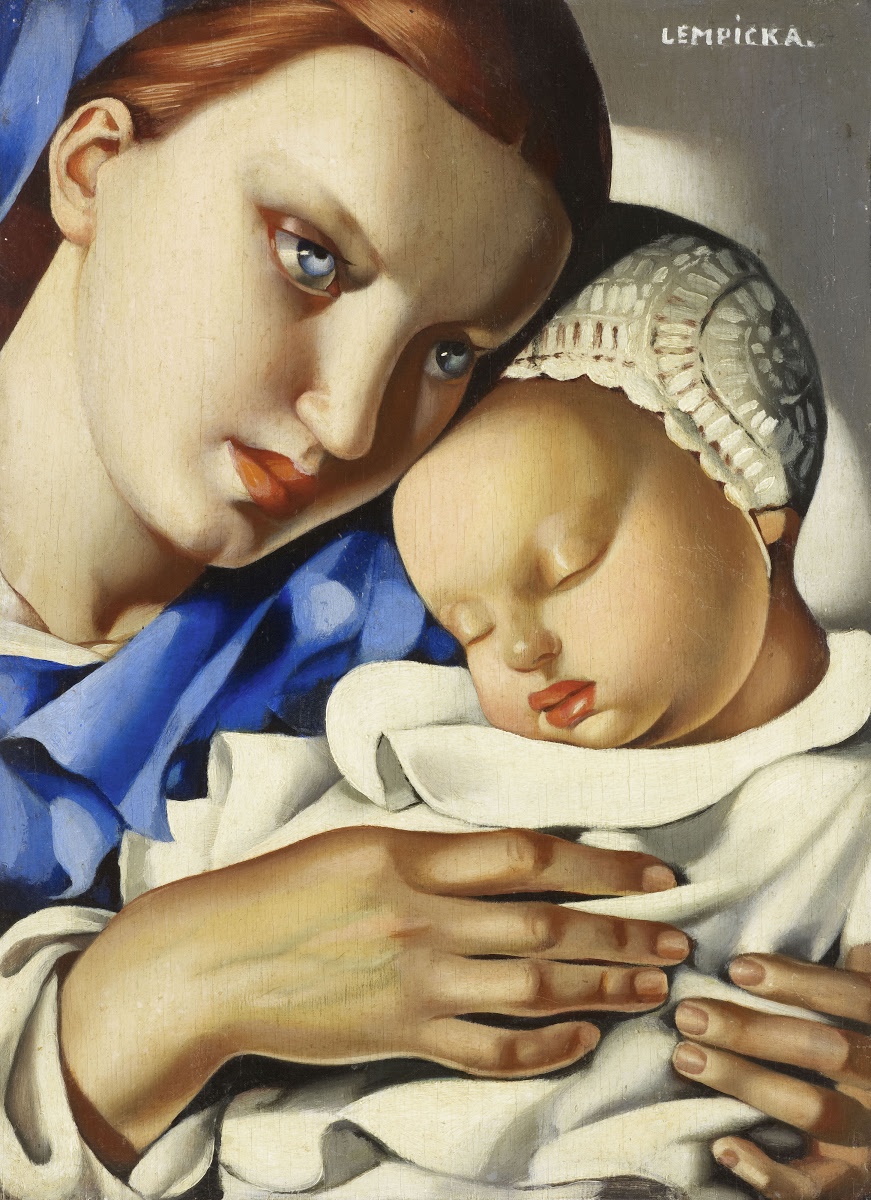
Mother and Child, 1931
Tamara de Lempicka (1898-1980)
Oil on wood
33 x 24 cm
Le MUDO - Musée de l'Oise, Beauvais, France
Migrant Mother depicts a mother with a helpless and worried expression on her face.

Migrant Mother, Nipomo, California, 1936
Dorothea Lange (1895-1965)
Gelatin silver print
28.3 x 21.8 cm
Museum of Modern Art, New York
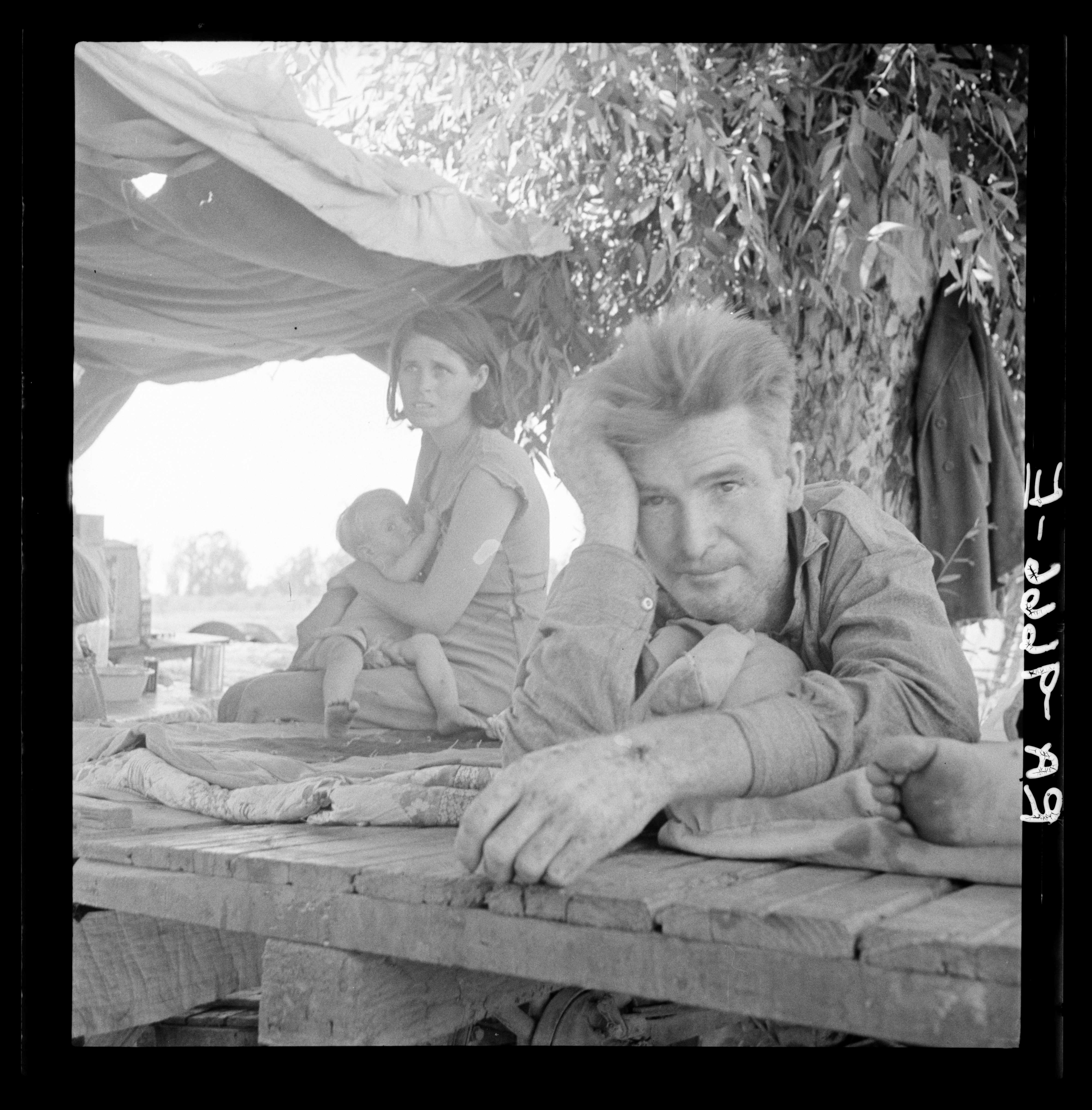
Drought refugees from Oklahoma camping by the roadside. They hope to work in the cotton fields. There are seven in family. Blythe, California, 1936 Aug
Dorothea Lange (1895-1965)
1 negative: nitrate
2 1/4 x 2 1/4 inches or smaller
Library of Congress, Washington, D.C.
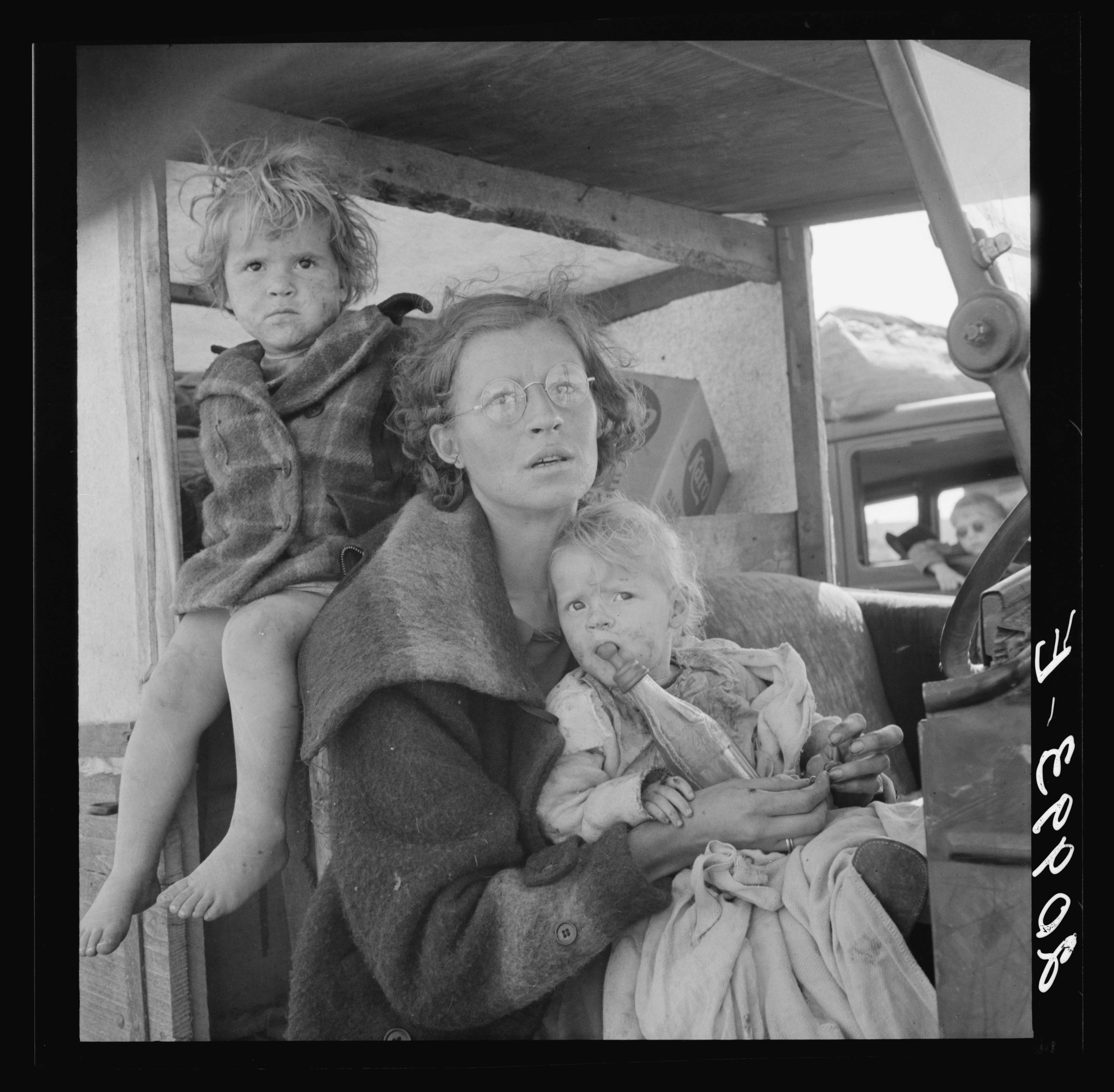
Mother and two children on the road. Tulelake, Siskiyou County, California. General caption number 65, 1939 Sept.
Dorothea Lange (1895-1965)
1 negative: nitrate
2 1/4 x 2 1/4 inches or smaller
Library of Congress, Washington, D.C.

Migrant potato pickers. Tulelake, Siskiyou County, California. General caption number 63-1, 1939 Sept.
Dorothea Lange (1895-1965)
1 negative: nitrate
2 1/4 x 2 1/4 inches or smaller
Library of Congress, Washington, D.C.
Marxism
Introduction
- Based on the theory of materialism, Marxism maintains that art is a mirror held up to real life.
- Art should not be dominated by capitalism and social hierarchy. Instead, art should be serving society by its very nature.
Application
- To gain a better understanding of the painting Woman Holding a Balance, we have to acquire the biographical knowledge of Vermeer and the contextual knowledge of the social circumstances of his time.
- Viewers should not be blinded by the decent appearance and elegant gesture of the young woman; instead, we should free ourselves from the so-called “aesthetic gaze”, which had long been upheld by the middle classes, and adopt a more critical approach to examining the painting.
- In Vermeer’s time, capitalism was booming in the prosperous seventeenth-century Netherlands, which accumulated wealth through engaging in ferocious naval warfare and exploitation of its colonies.
- The young woman depicted in the painting was not directly involved in those activities, but she willingly purchased those gold and jewellery, and hence was indirectly held accountable for the exploitation of other people and the environment.
- Why did the young woman weigh the jewellery? Who were the buyers? What was the motive behind it? Would she gain any profits from the dealings?
- Vermeer's artistic production was small. Relying on the financial contributions of his mother-in-law, Vermeer was able to indulge himself in drawing his ideal subject matter in a leisure manner, while prioritizing his personal preferences over the actual way of living and needs of the working class in his artistic expression.
Pearl jewellery wore by women of noble birth, as demonstrated in contemporary paintings in Vermeer’s time.

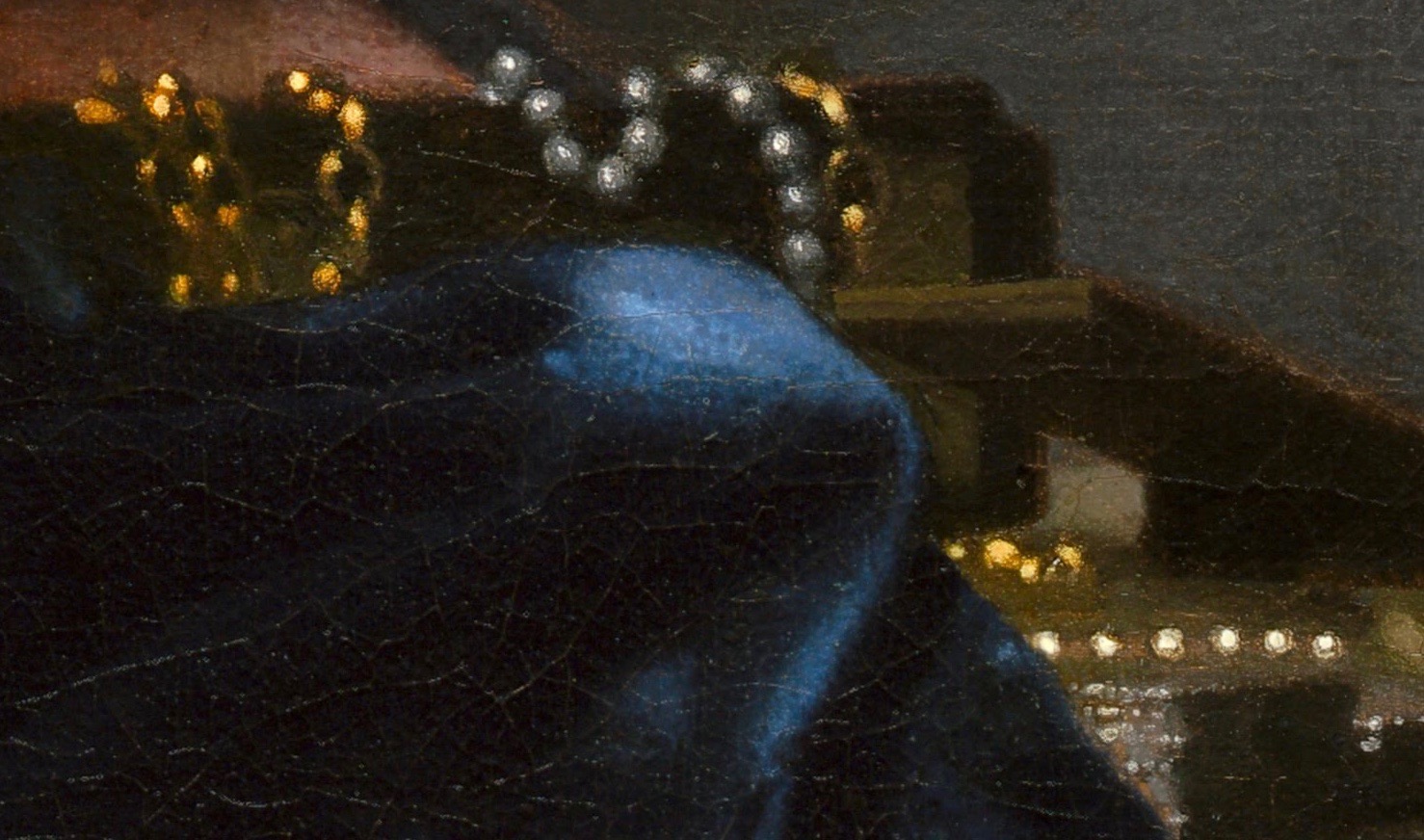
Detail

Portrait of Jacoba van Orliens, Wife of Jacob de Witte of Haamstede, 1660
Jan Mijtens (1614 - 1670)
Oil on canvas
113 × 91 cm
Rijksmuseum, Amsterdam
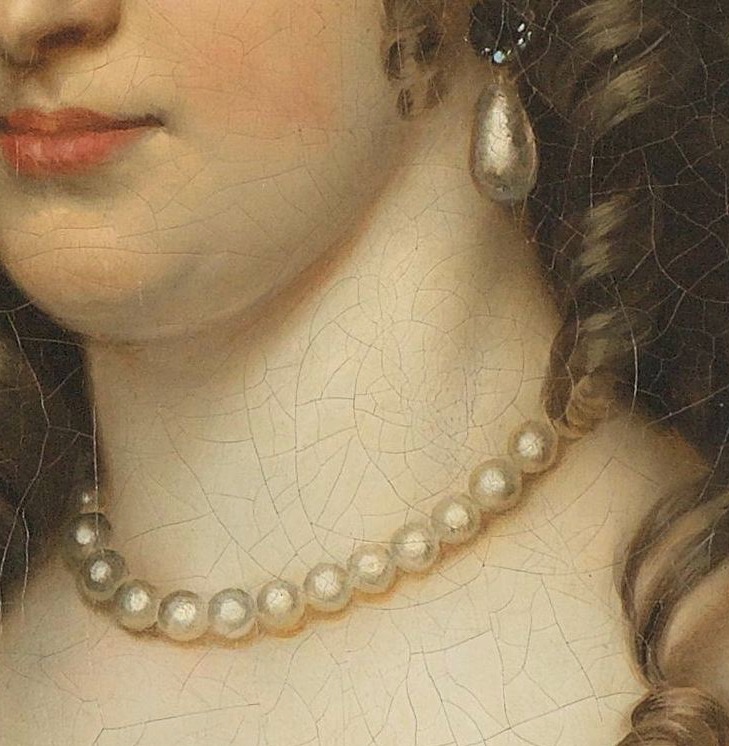
Detail

Portrait of Anna Boudaen Courten, 1619
Salomon Mesdach (1600 - 1632)
Oil on panel
94.6 × 68.9 cm
Rijksmuseum, Amsterdam
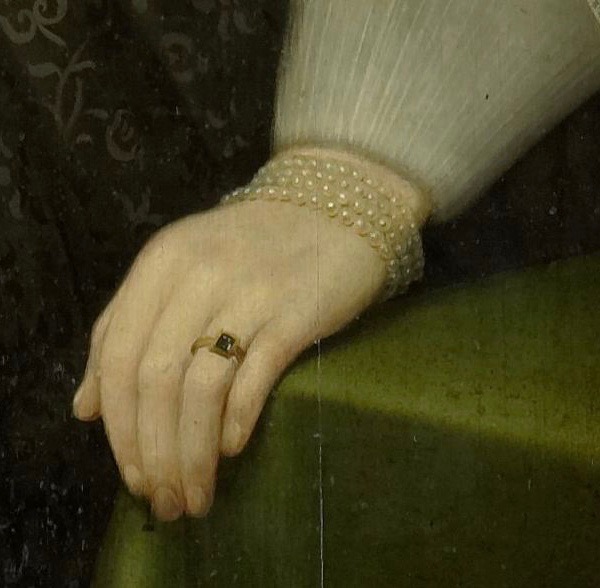
Detail

Wife of Aert van Nes, Bartholomeus van der Helst, 1668
Geertruida den Dubbelde (1647 - 1684)
Oil on canvas
139 × 125 cm
Rijksmuseum, Amsterdam
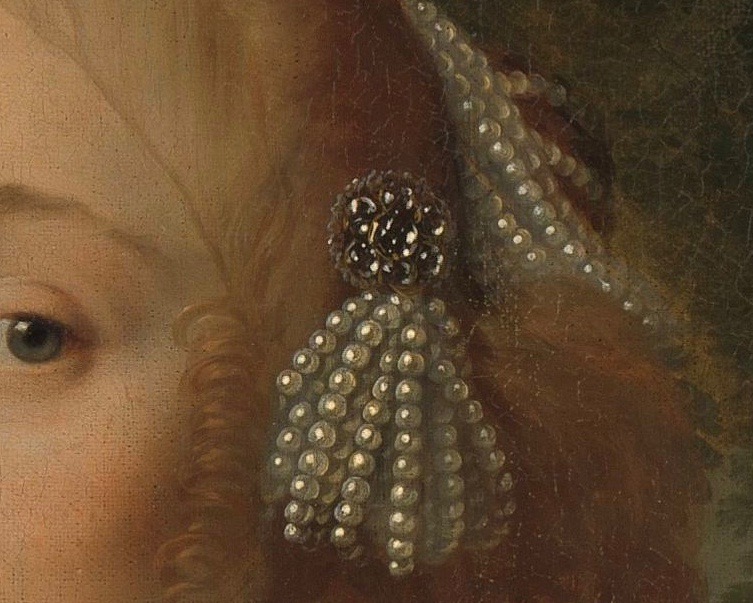
Detail
At the time, the Netherlands was a naval power with a strong fleet, actively engaging in maritime expansion and acquisition of overseas territories.

The Departure of a Dignitary from Middelburg, 1615
Adriaen Pietersz. van de Venne (c. 1589 – 1662)
Oil on panel
63.2 x 131.6 cm
Rijksmuseum, Amsterdam
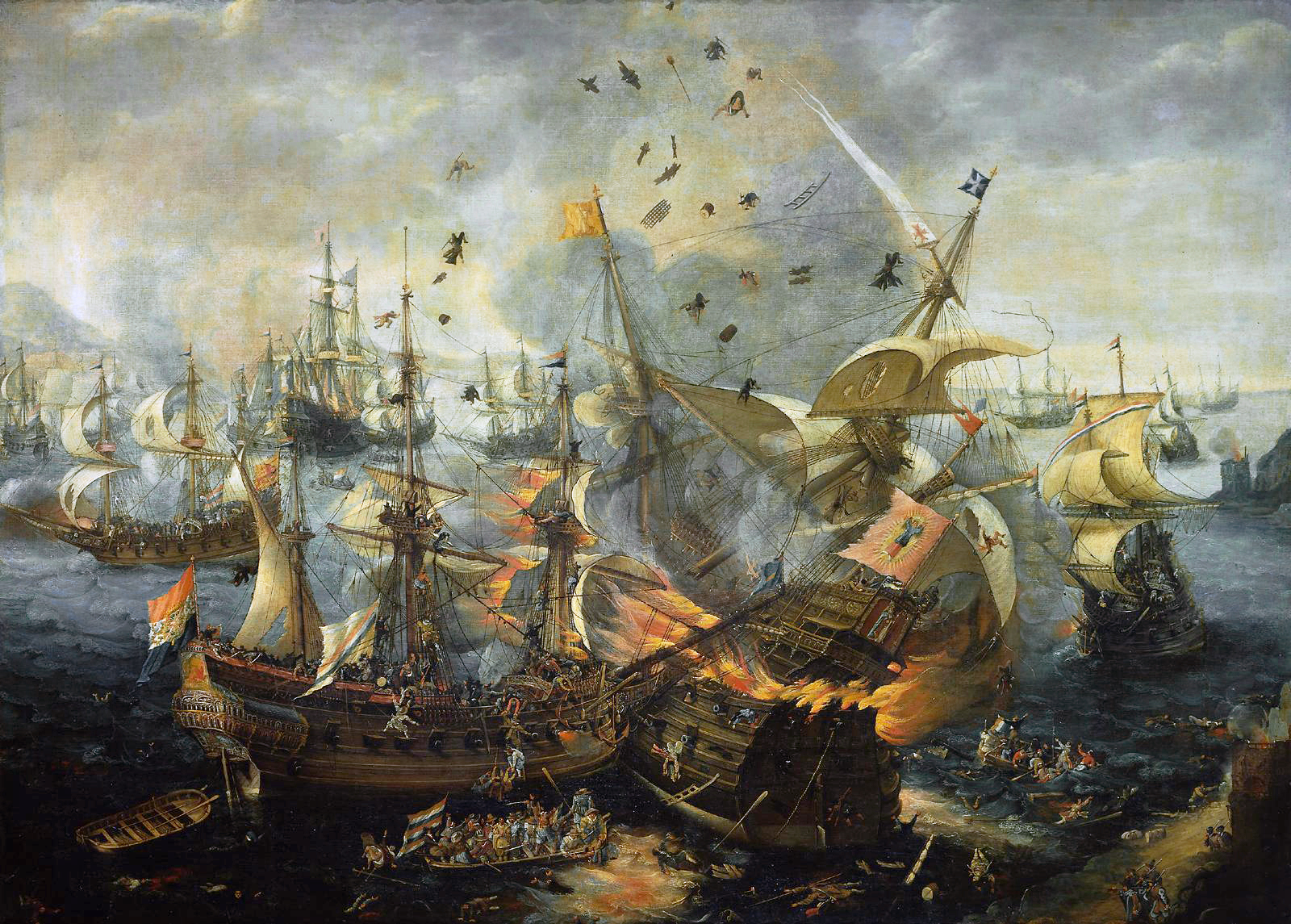
Battle of Gibraltar in 1607, c. 1621
Cornelis Claesz van Wieringen (1577–1633)
Oil on canvas
136.8 x 187 cm
Rijksmuseum, Amsterdam
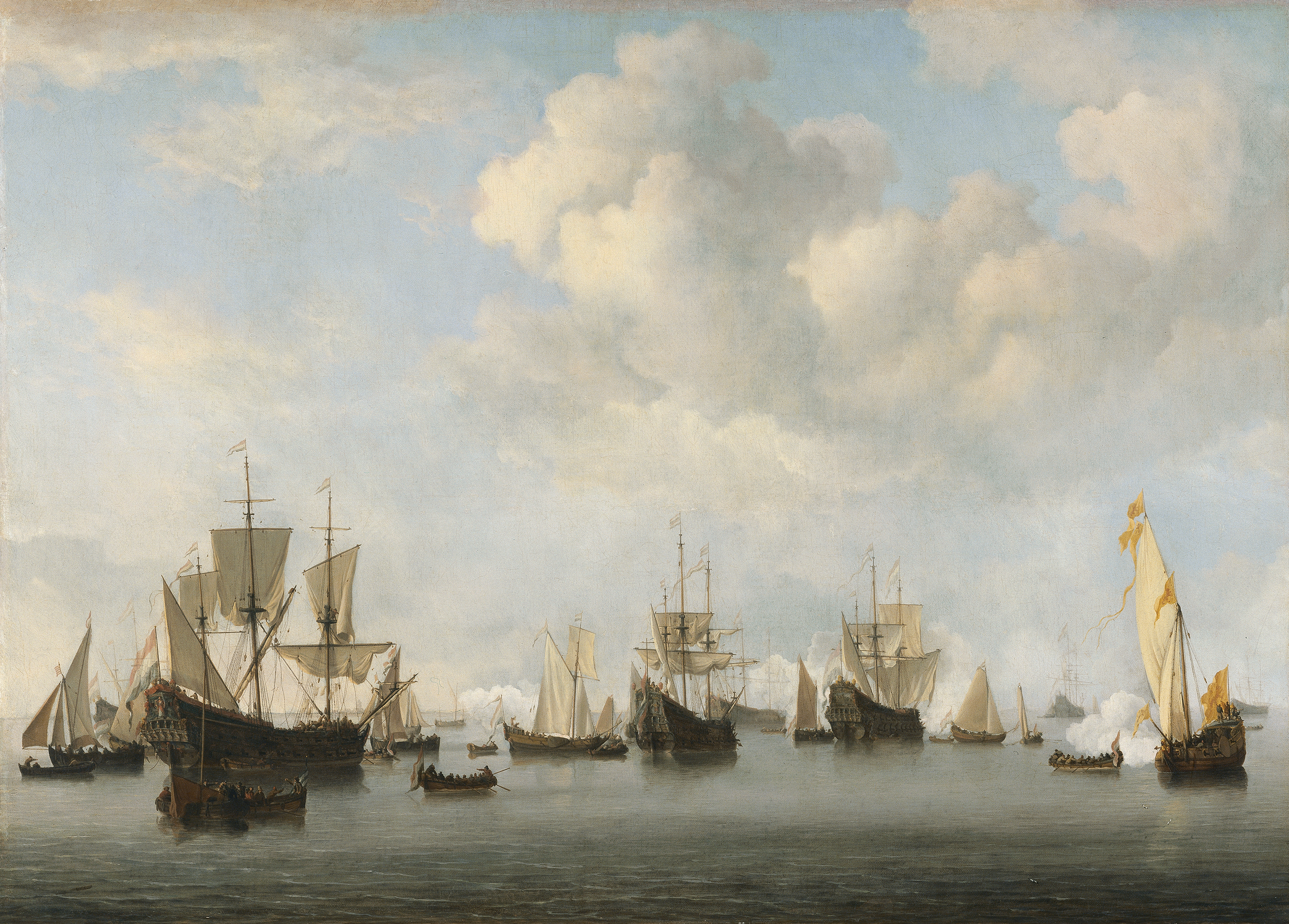
The Dutch Fleet in the Goeree Roads, c. 1672 – 1673
Willem van de Velde the Younger (1633-1707)
Oil on canvas
69.5 x 97.8 cm
Museo Nacional Thyssen-Bornemisza, Madrid
The 17th century is considered as the “Dutch Golden Age”. At the time, the Dutch East Indian Company (VOC) had been monopolizing the trade with Asia over two centuries. Meanwhile, as a maritime and economic power, the Netherlands made efforts to establish its colonial empire and trading posts around the world.
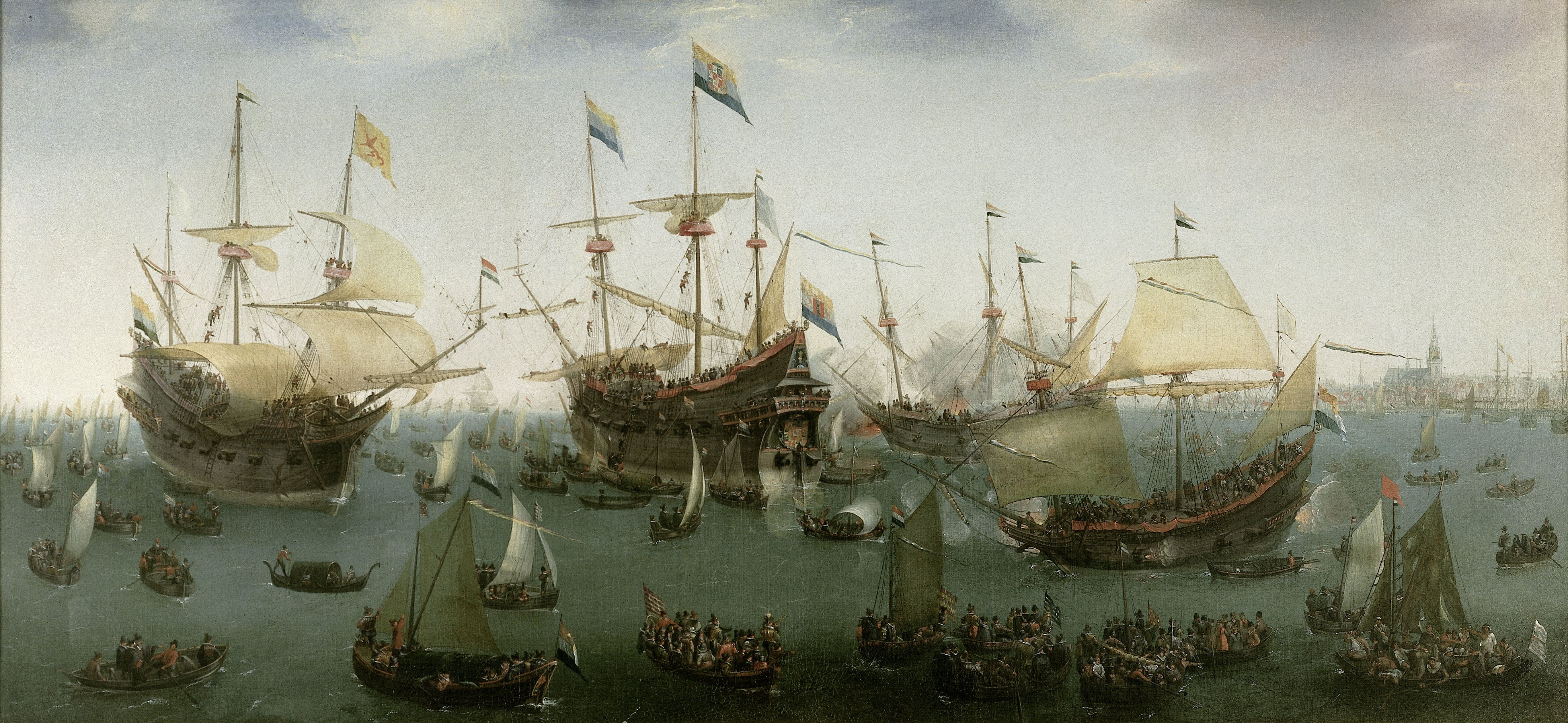
The Return to Amsterdam of the Second Expedition to the East Indies, 1599
Hendrick Cornelisz Vroom (1562/1563–1640)
Oil on canvas
102.3 × w 218.4
Rijksmuseum, Amsterdam

VOC Senior Merchant, c. 1640 - c. 1660
Aelbert Cuyp (1620-1691)
Oil on canvas
138 × 208 cm
Rijksmuseum, Amsterdam
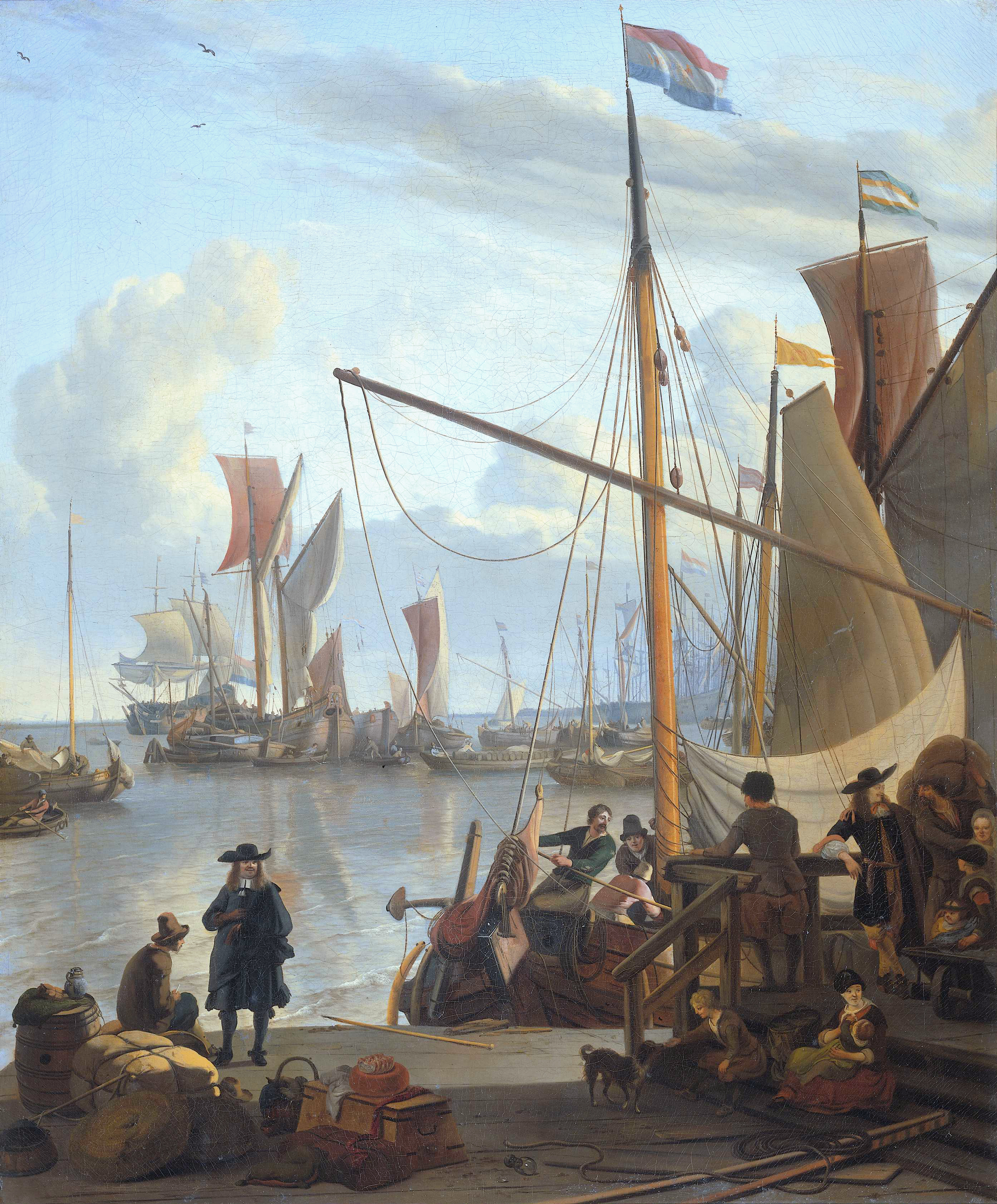
View from the Mussel Pier in Amsterdam, 1673
Ludolf Bakhuizen (1630–1708)
Oil on canvas
81 x 67 cm
Rijksmuseum, Amsterdam

Jan van Riebeeck arrives in Table Bay in April 1652
Charles Davidson Bell (1813 - 1882)
Oil on canvas
After marriage, financial difficulties prompted Vermeer to move to live with his wealthy mother-in-law for her support.

Maria Thins (c. 1593 – 27 December 1680) was the mother-in-law of Johannes Vermeer and a member of the Gouda Thins family.
Feminism
Introduction
- Feminist approach to artistic criticism is underpinned by discussions on interactions between women and men, resistance to oppressive patriarchy, and the repositioning of women’s gender role.
- The early studies focus on how women are sidelined in mainstream art and the formation of hegemonic masculinity.
- Illustrating how women are objectified by male gaze is central to the later studies.
Application
- Woman Holding a Balance is typically a pictorial misrepresentation of women by men.
- In the painting, the young woman is absorbed in a so-called “feminine” activity: weighing the jewellery conscientiously, which demonstrates the gentle, humble and refined femininity.
- A visual, moral and religious beauty is embodied in the young woman’s blue jacket, which is iconic costume of the Virgin Mary, as well as the gentle expression in her eyes – it is typically men’s projection of an image of ideal women.
- The young woman, endowed with the mixed roles of mother and wife, serves as an ideal in patriarchal society, providing men with spiritual and physical support.
- In general, sunlight coming through the window represents God in Christian culture – which appears as a male God in the painting.
- The young woman, who demonstrates her feminine virtues, is illuminated by the sunlight endowing her with a nimbus, a circular cloud of light surrounding a divine person. Her existence is a gift from God (a male God), who confers honor on her.
Most of Vermeer’s works depict women situated in private settings, engaging in women's activities in a conscientious manner, and hence demonstrating the tenderness and refinement of femininity.
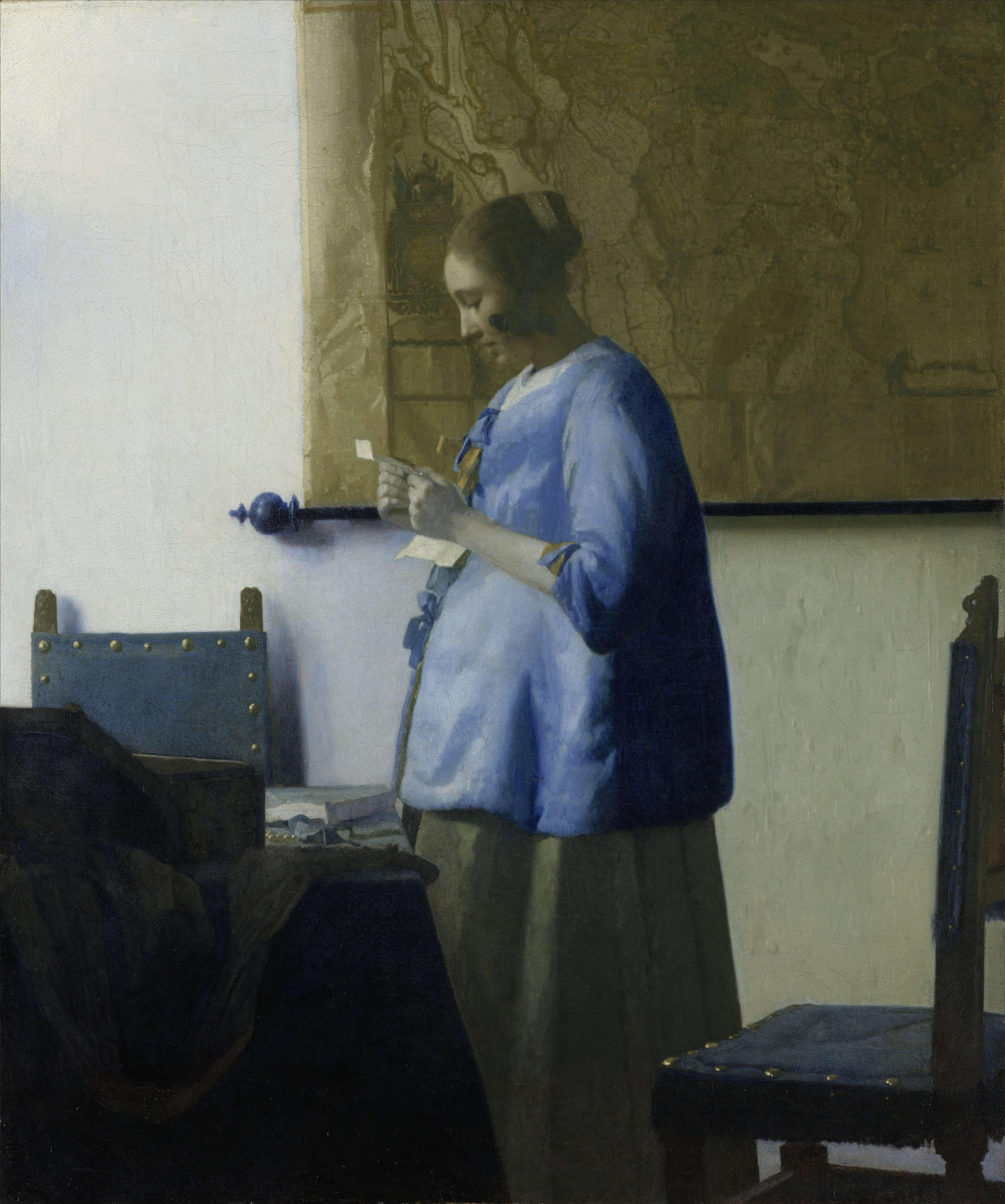
Woman in Blue Reading a Letter, c. 1662 – 1665
Johannes Vermeer (1632 - 1675)
Oil on canvas
46.5 x 39 cm
Rijksmuseum, Amsterdam
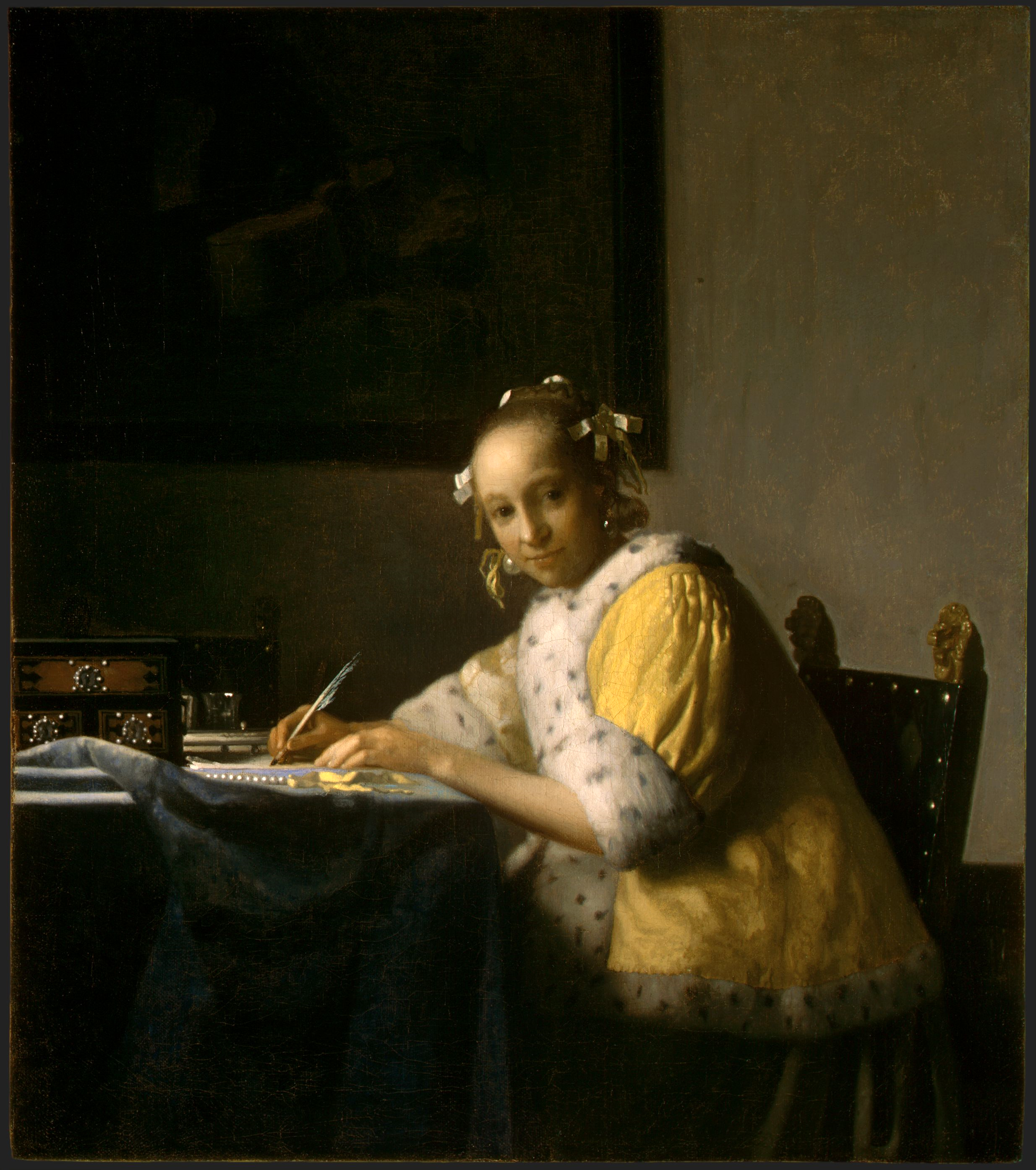
A Lady Writing, c. 1662 – 1667
Johannes Vermeer (1632 - 1675)
Oil on canvas
45 x 39.9 cm
National Gallery of Art, Washington D.C.
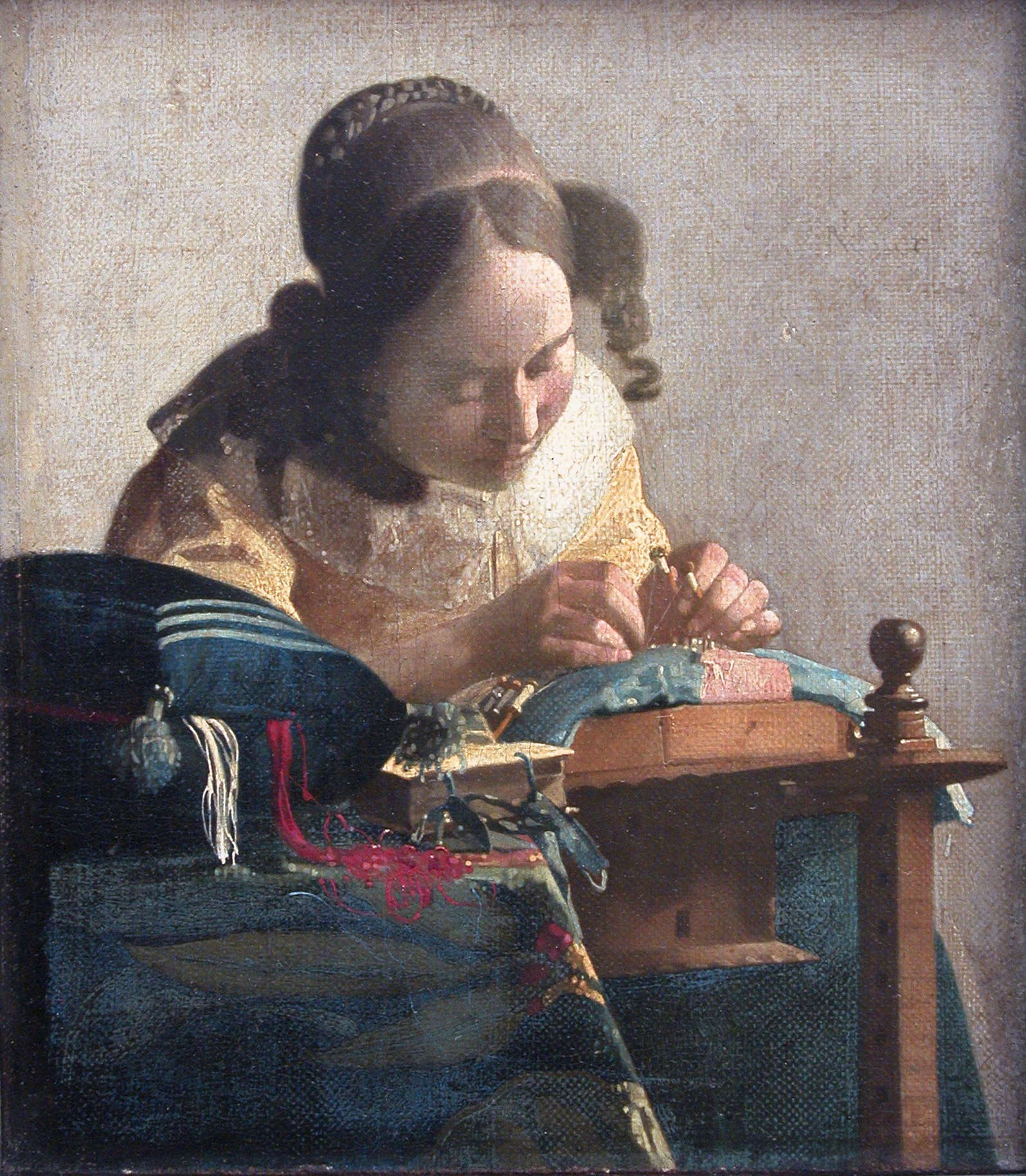
The Lacemaker, c. 1669 – 1671
Johannes Vermeer (1632 - 1675)
Oil on canvas
24.5 x 21 cm
Musée du Louvre, Paris
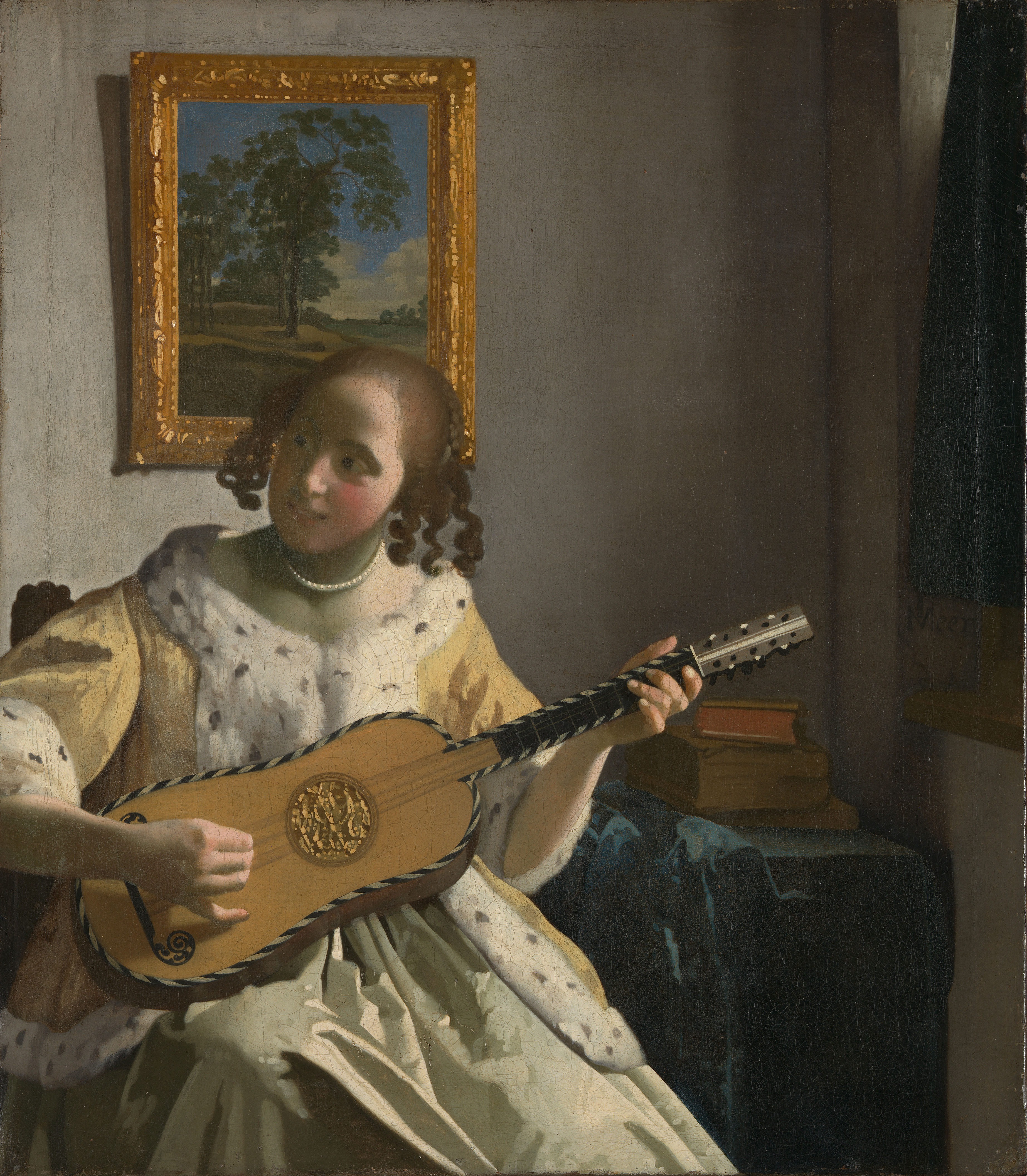
The Guitar Player, c. 1670 – 1673
Johannes Vermeer (1632 - 1675)
Oil on canvas
53 x 46.3 cm
Kenwood House English Heritage as Trustees of the Iveagh Bequest, London
An ideal woman, endowed with mixed roles of mother and wife, is reflected in the image of the young woman dressed in the blue jacket (which resembles the iconic costume of the Virgin Mary) and the gentle expression in her eyes.


The Expectant Madonna with Saint Joseph, c. 1425/1450
French 15th Century
Tempera on European walnut
70.5 x 35 cm
National Gallery of Art, Washington, D.C.

The Arnolfini Portrait, 1434 (detail)
Jan van Eyck (1390 - 1441)
Oil on oak
82.2 x 60 cm
National Gallery, London
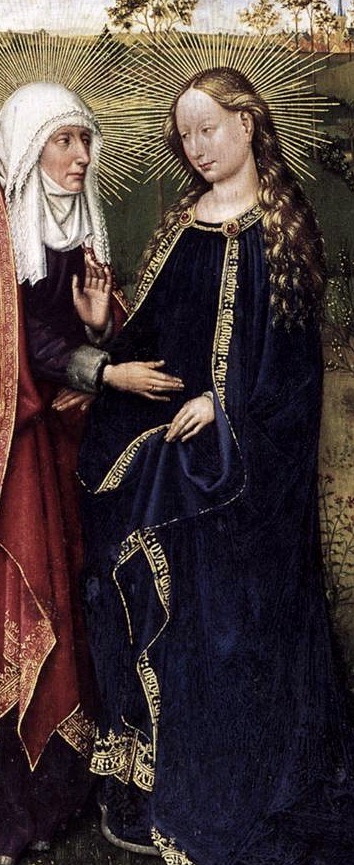
Visitation, 1434-35
Jacques Daret (c. 1404 - 1470)
Oil on oak panel
57 x 52 cm
The Berlin State Museums, Berlin
Sunlight coming through the window represents the male God in Christian culture.


Saint John the Evangelist on Patmos, c. 1553/1555
Titian (c. 1488/1490 – 1576)
Oil on canvas
237.6 x 263 cm
National Gallery of Art, Washington, D.C.

The Virgin as Intercessor, c. 1628/1629
Sir Anthony van Dyck (1599 – 1641)
Oil on canvas
118.8 x 102.3 cm
National Gallery of Art, Washington, D.C.

The Newborn Child, c. 1645 - 1648
Georges de La Tour (1593 - 1652)
Oil on canvas
76 x 91 cm
Muesum of Fine Arts of Rennes, Rennes
Psychoanalysis
Introduction
- Freudian criticism and psychoanalytic theory concern symbolic representation of creators’ inner state and expression of artists’ repressed sexual desires.
Application
- The dark blue cloth at the bottom left corner of the painting forms a strange shape, with its contour creating a long stripe of crack. The deep dark hole bears a resemblance to a female reproductive organ.
- In the painting, the misplaced reproductive organ reflects the subconsciousness of the painter Vermeer who wants to detach the young woman from her sexuality.
- Both the young woman’s jacket and the tablecloth are rendered in blue. It is not merely out of aesthetic consideration, but reflects that Vermeer unconsciously associates the woman with the cloth.
- For men, female reproductive organ is emblematic of castration anxiety which leads to the fear of death.
- Beside the blue cloth forming the shape of a “hole”, Vermeer depicts golden and pearl necklaces spilled over the table.
- Female reproductive organ is both the allegory of death and the source of seduction.
- The misplaced genital organ is allegorical not only in the sense that Vermeer wanted to free himself from sexuality at the stage of infancy, but also that the artist was unable to openly acknowledge his sexual desires.
- The snake-like object under the table is an emblem of male genital organ of the artist himself. It underlines the theme of the painting - sex is vitally important but unsettling.
In the painting, the dark blue cloth at the bottom left corner echoes the shape of female reproductive organ.

The depiction of golden and pearl necklaces, next to the blue cloth in the shape of a “hole”, indicates the seduction of female reproductive organ.

The jacket of the young woman and the tablecloth are both rendered in blue. It shows that the artist unconsciously associates the two.

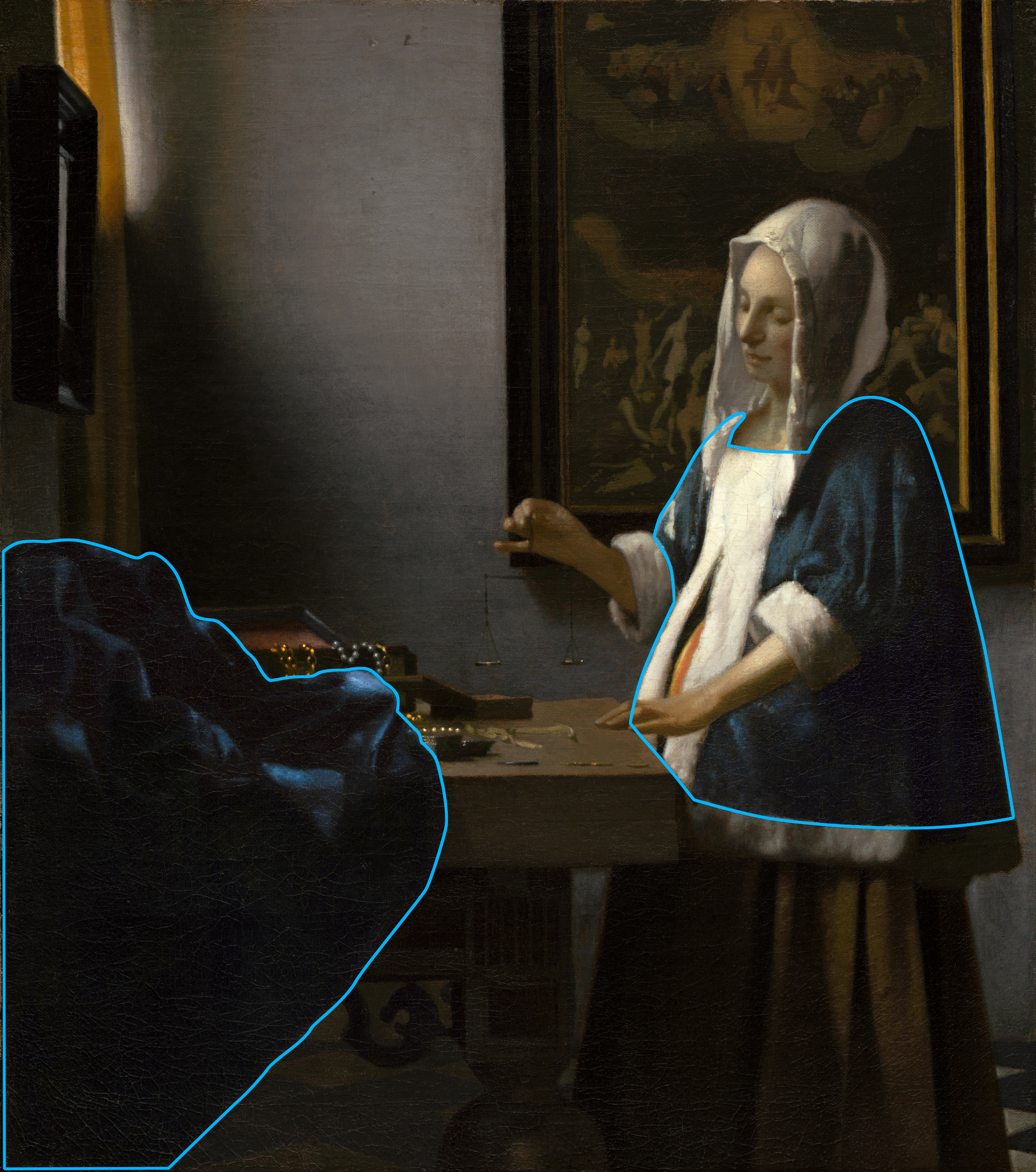
The snake-like object under the table is an emblem of male genital organ of the artist himself.

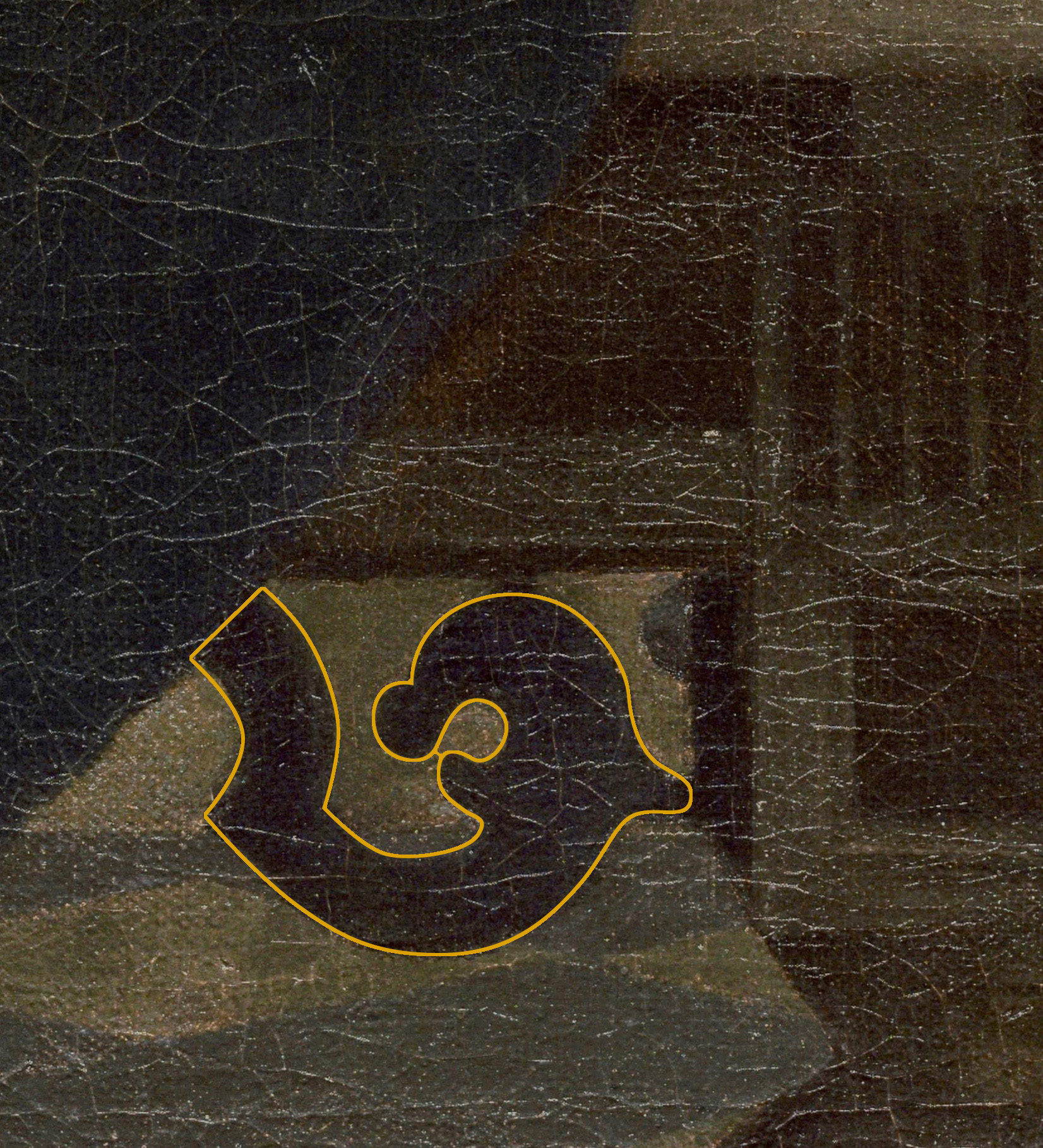
Semiology
Introduction
- In Semiotics, artworks are constituted by sign, signifier and signified, through which symbolic meanings and cultural implications are produced and communicated.
Application
- In the painting, the young woman weighs the jewellery with the scales, in order to judge their values. It resembles the theme of the Last Judgment.
- The painting of the Last Judgment depicts the scene of the Day of Judgment, in which the Christ on the throne examines the conscience and weighing the sins of mortal men before making measured judgment.
- The image of the Christ appears above the head of the young woman, while the raised hands of the Christ echo the scales at the centre of the painting.
- The judgments of the Christ are eternal, while those of the young woman are temporal. The consequences are different, but their considerations are equally conscientious.
- The scales held by the young woman are empty, indicating that her gesture is allegorical. It suggests that what she is weighing is not worldly matter, but something spiritual.
- The mirror next to the window represents the pursuit of self-knowledge and self-reflection, suggesting that the young woman should make reasonable judgment of her own deeds, and that it all comes down to the judgment of God.
- The young woman is an explicit allegory of the Virgin Mary: pearls represent the vanity of worldliness, and the young woman, with elegant gesture and a gentle expression in her eyes, is dressed in a blue jacket, which resembles the iconic costume of the Virgin Mary.
There is a close thematic relationship between Vermeer’s painting and the Last Judgment: the young woman weighs the jewellery to make a measured judgment of their values, while the Christ weighs the conscience and sins of mortal men in the Last Judgment. Besides, the raised hands of the Christ echo the shape of the scales.



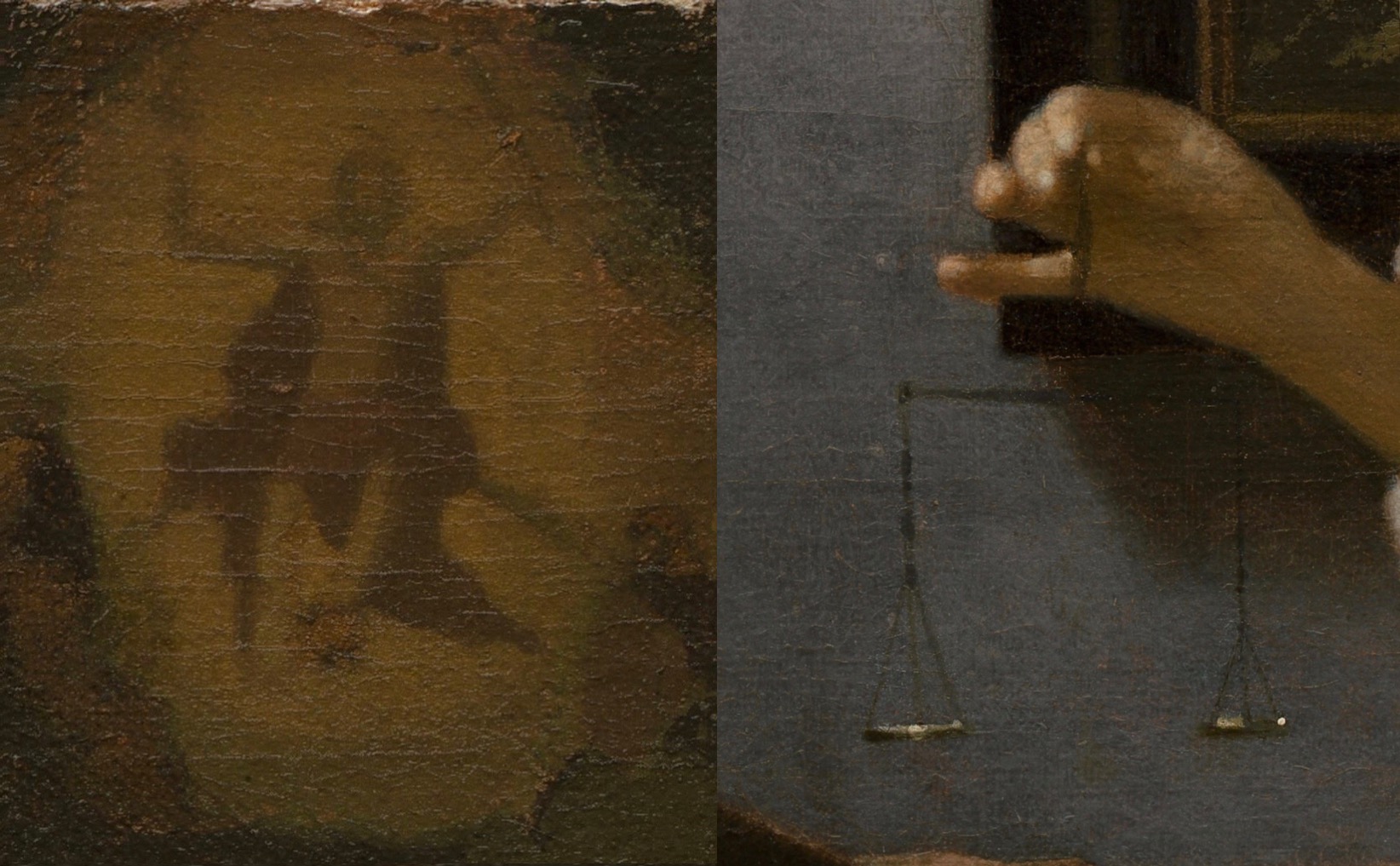
Everything in the painting is symbolic and allegorical: the young woman’s gesture and expression, the image of the Christ in the Last Judgment, the sunlight coming through the window, the mirror next to the window, the jewellery spilled over the table, etc.
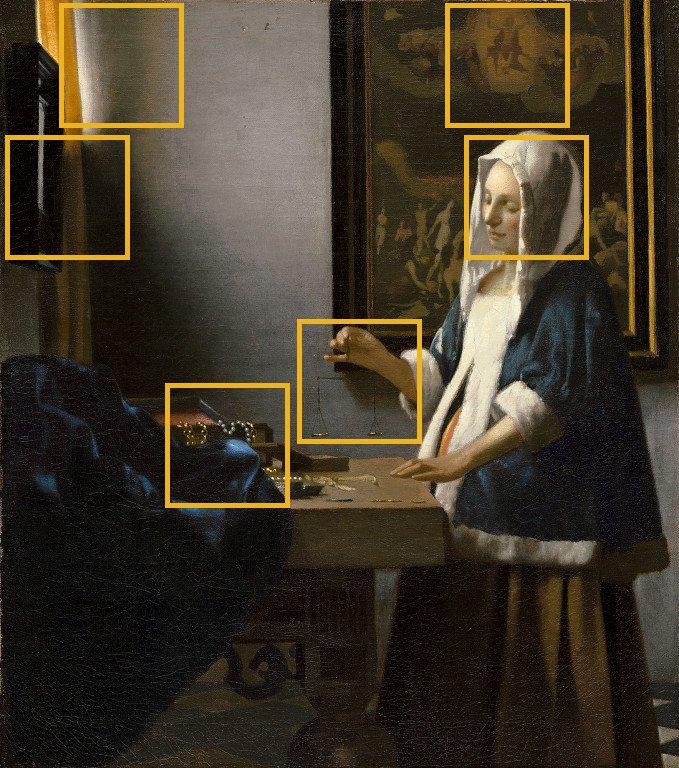
A woman holding a mirror up to herself represents self-reflection.
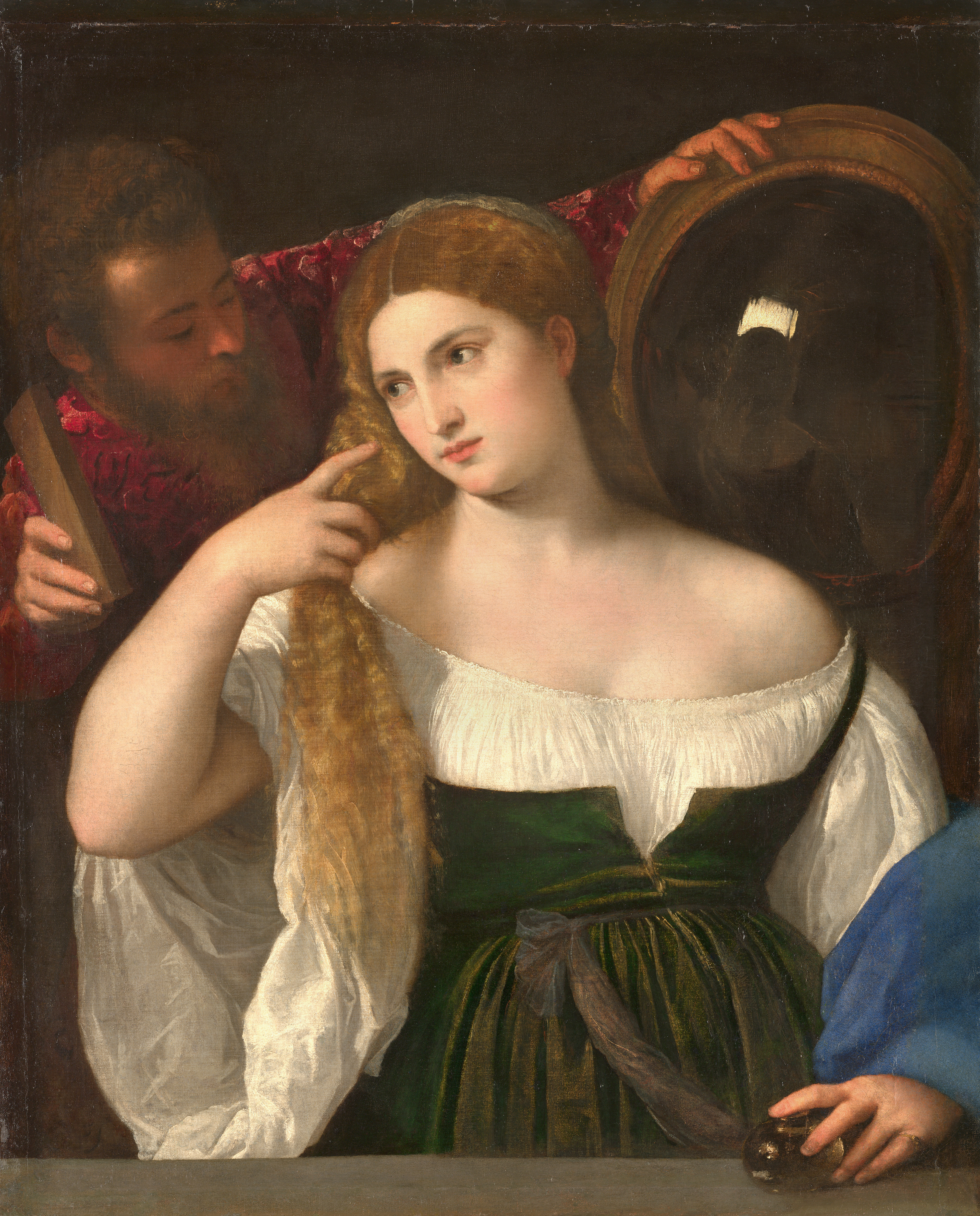
Woman with a Mirror, c. 1515
Titian (c. 1488/1490 – 1576)
Oil on canvas
99 × 76 cm
Musée du Louvre, Paris
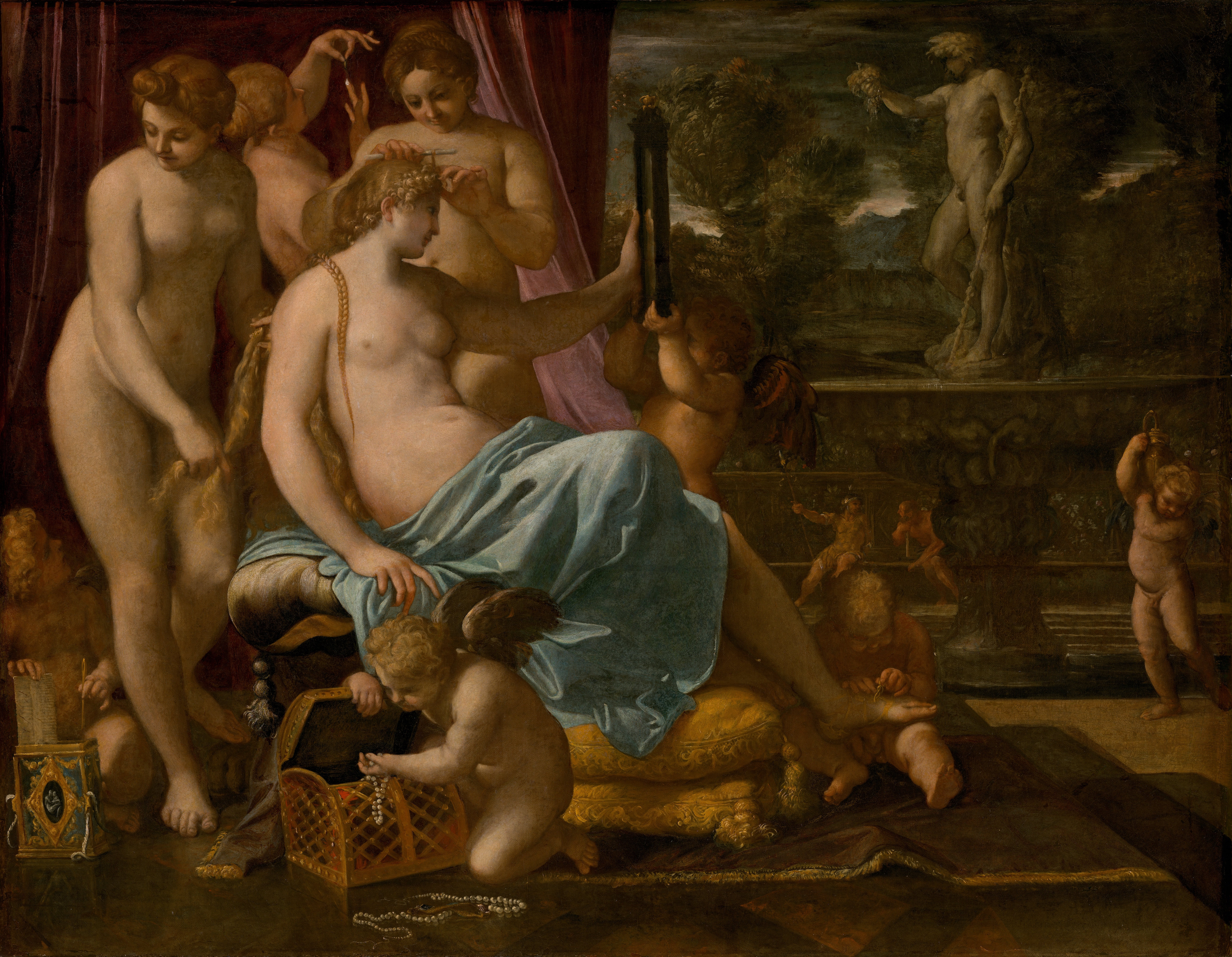
Venus Adorned by the Graces, 1590/1595
Annibale Carracci (1560–1609)
Oil on panel transferred to canvas
133 x 170.5 cm
National Gallery of Art, Washington, D.C.
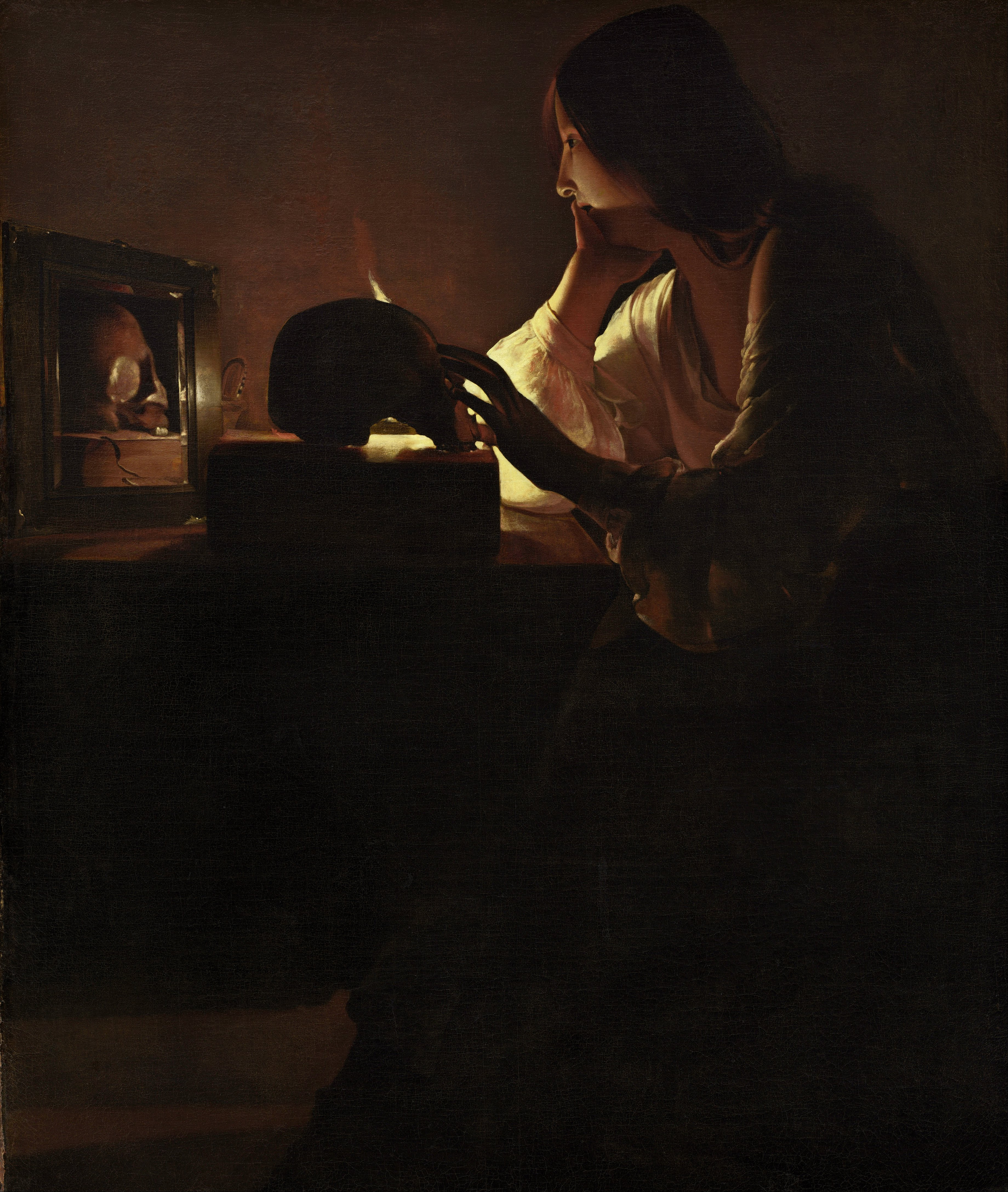
The Repentant Magdalen, c. 1635/1640
Georges de La Tour (1593–1652)
Oil on canvas
113 x 92.7 cm
National Gallery of Art , Washington, D. C.
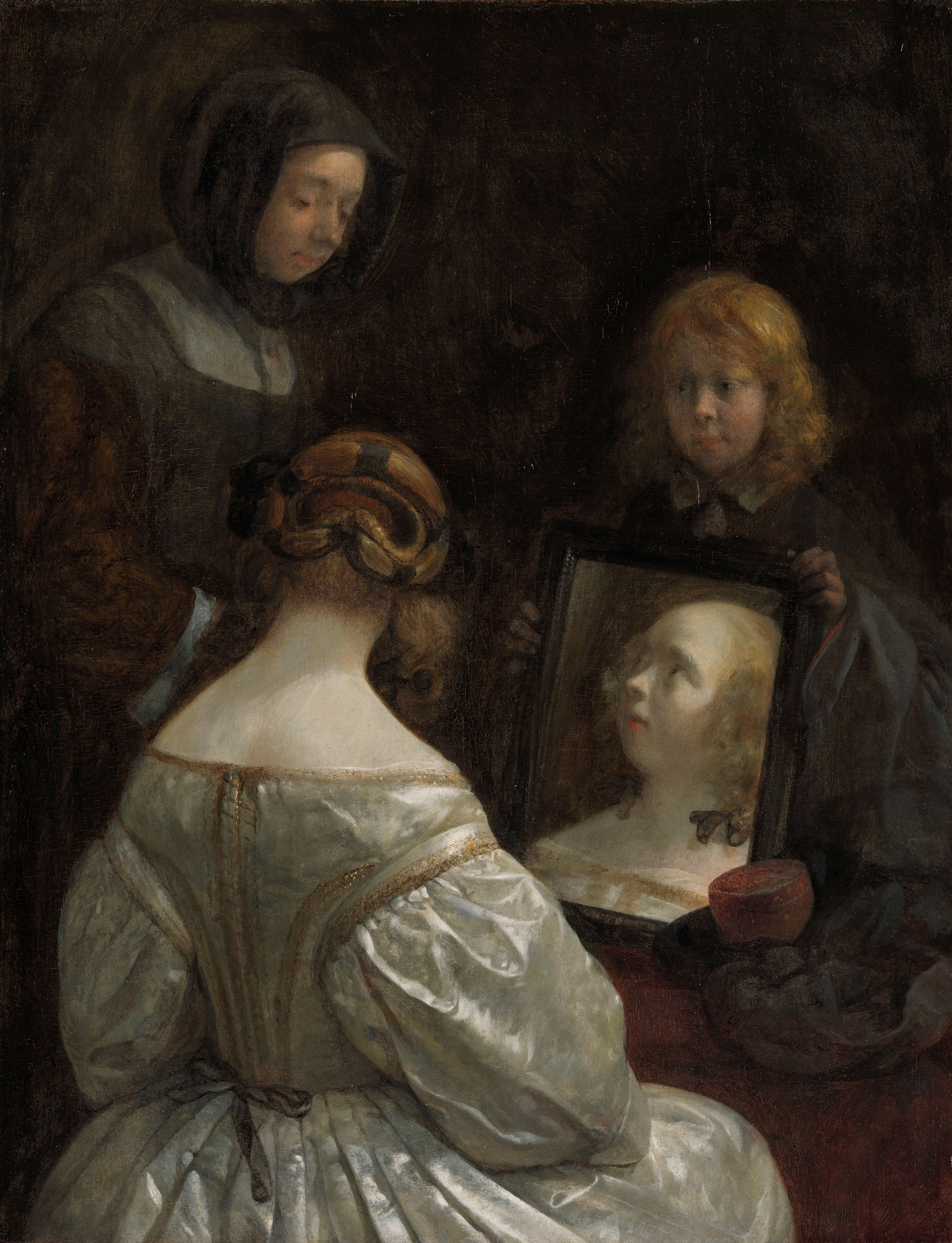
Woman at a Mirror, c. 1652
Gerard ter Borch (1617 - 1681)
Oil on panel
34.5 × 26 cm
Rijksmuseum, Amsterdam
The pearls in the painting represent the vanity of worldliness.
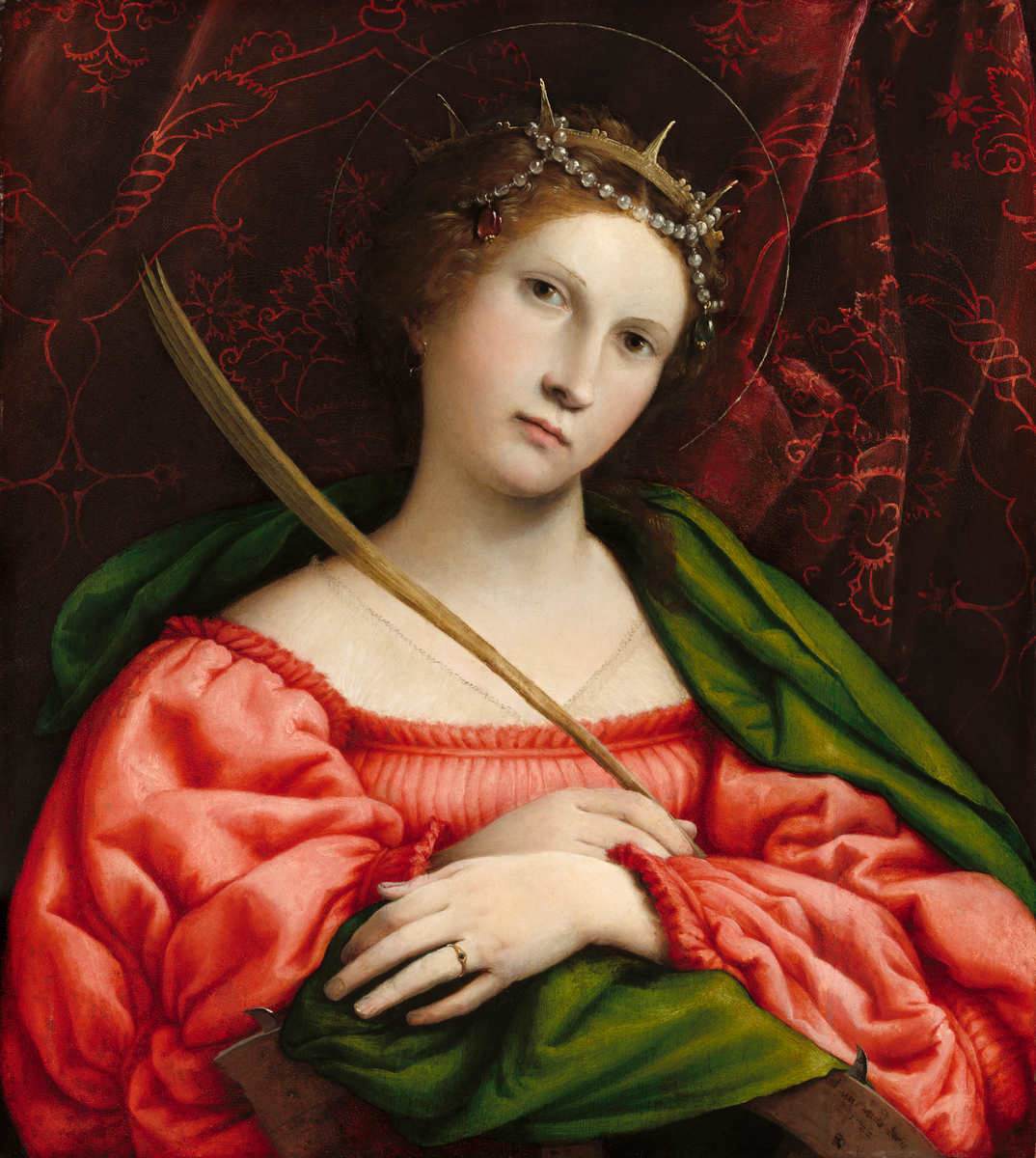
Saint Catherine, 1522
Lorenzo Lotto (c. 1480 - 1556/ 1557)
Oil on panel
57.2 x 50.2 cm
National Gallery of Art, Washington, D.C.
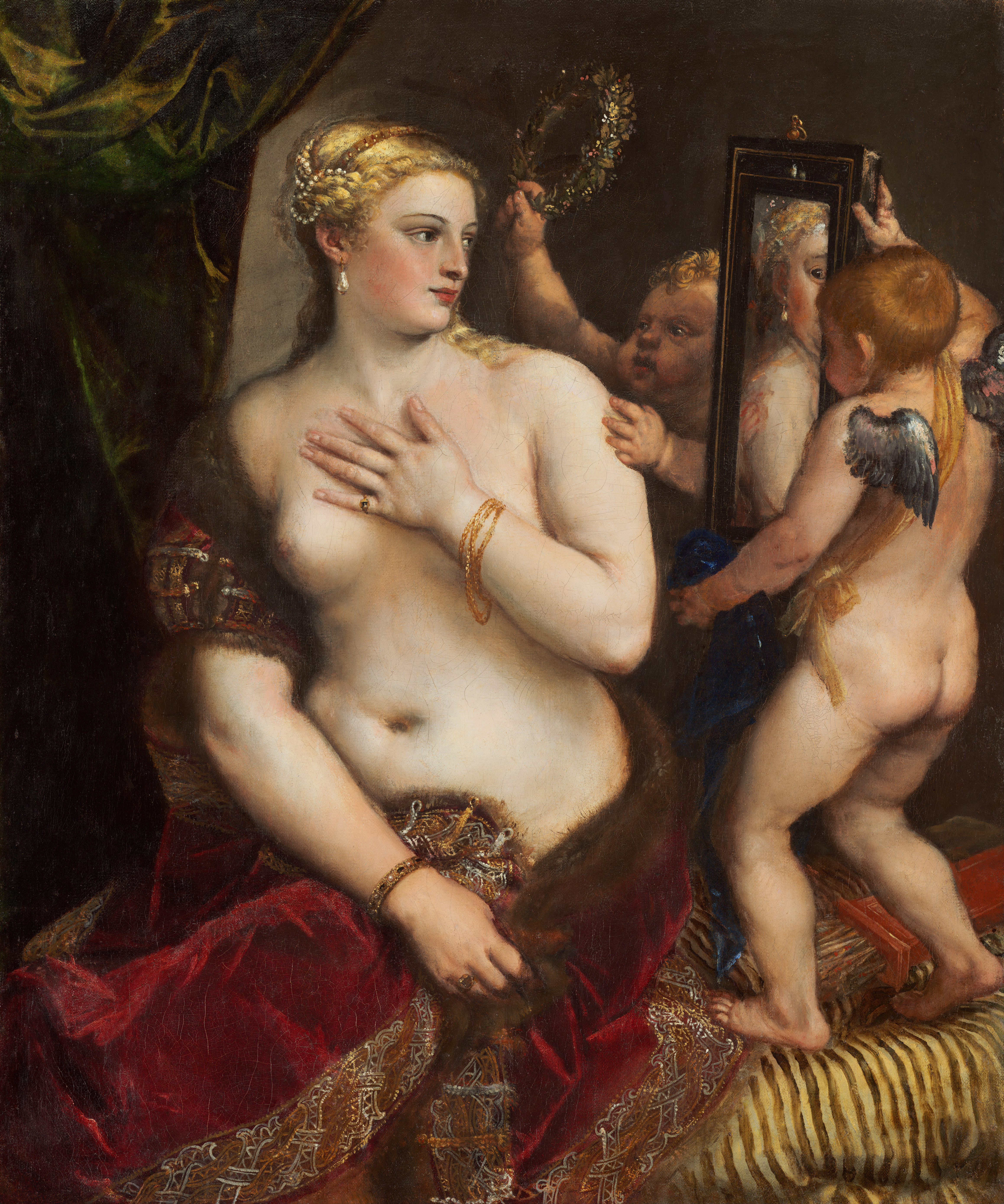
Venus with a Mirror, c. 1555
Titian (c. 1488/ 1490 - 1576)
Oil on canvas
124.5 × 105.5 cm
National Gallery of Art, Washington, D.C.
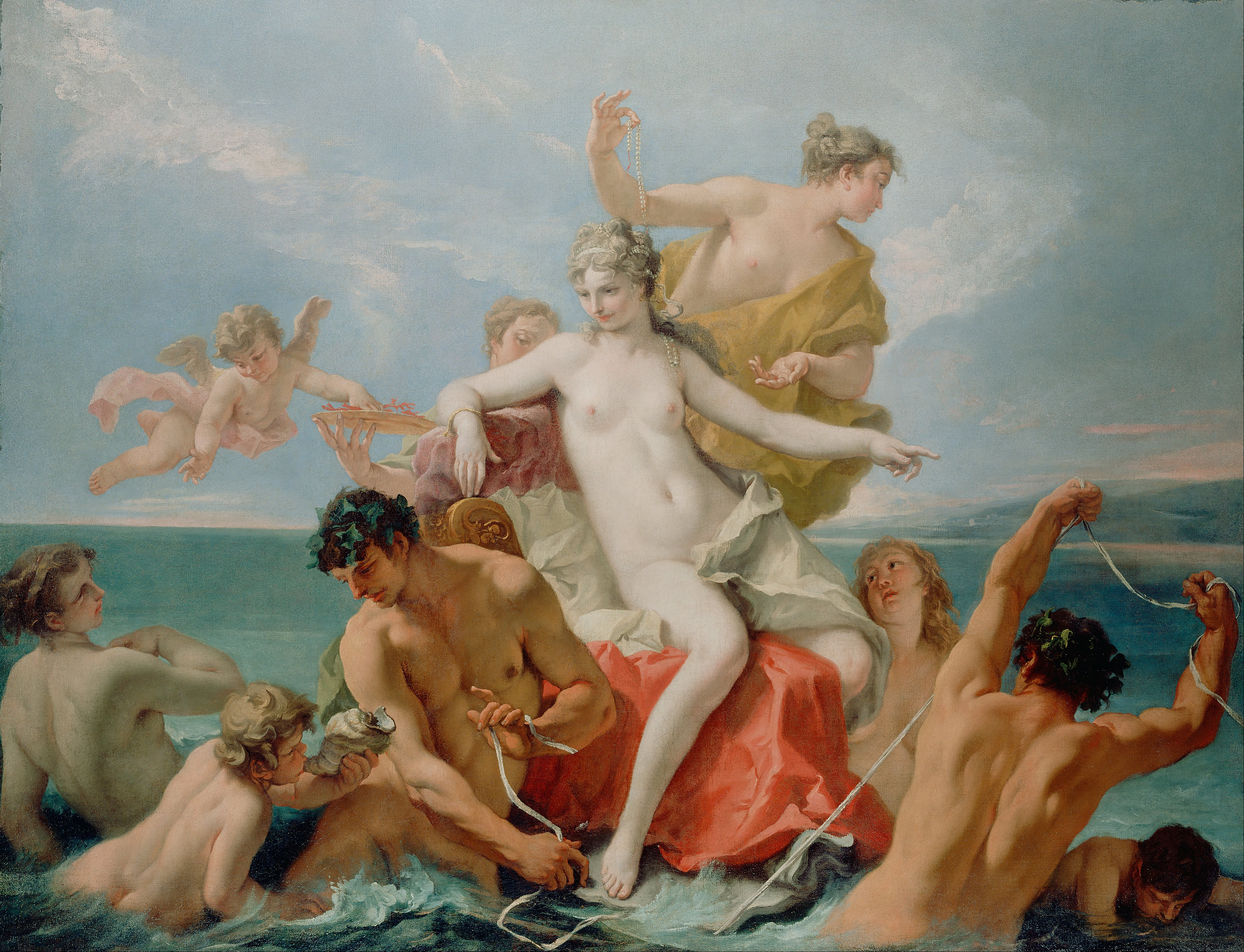
Triumph of the Marine Venus, c. 1713
Sebastiano Ricci (1659–1734)
Oil on canvas
160 x 210.8 cm
J. Paul Getty Museum, Los Angeles
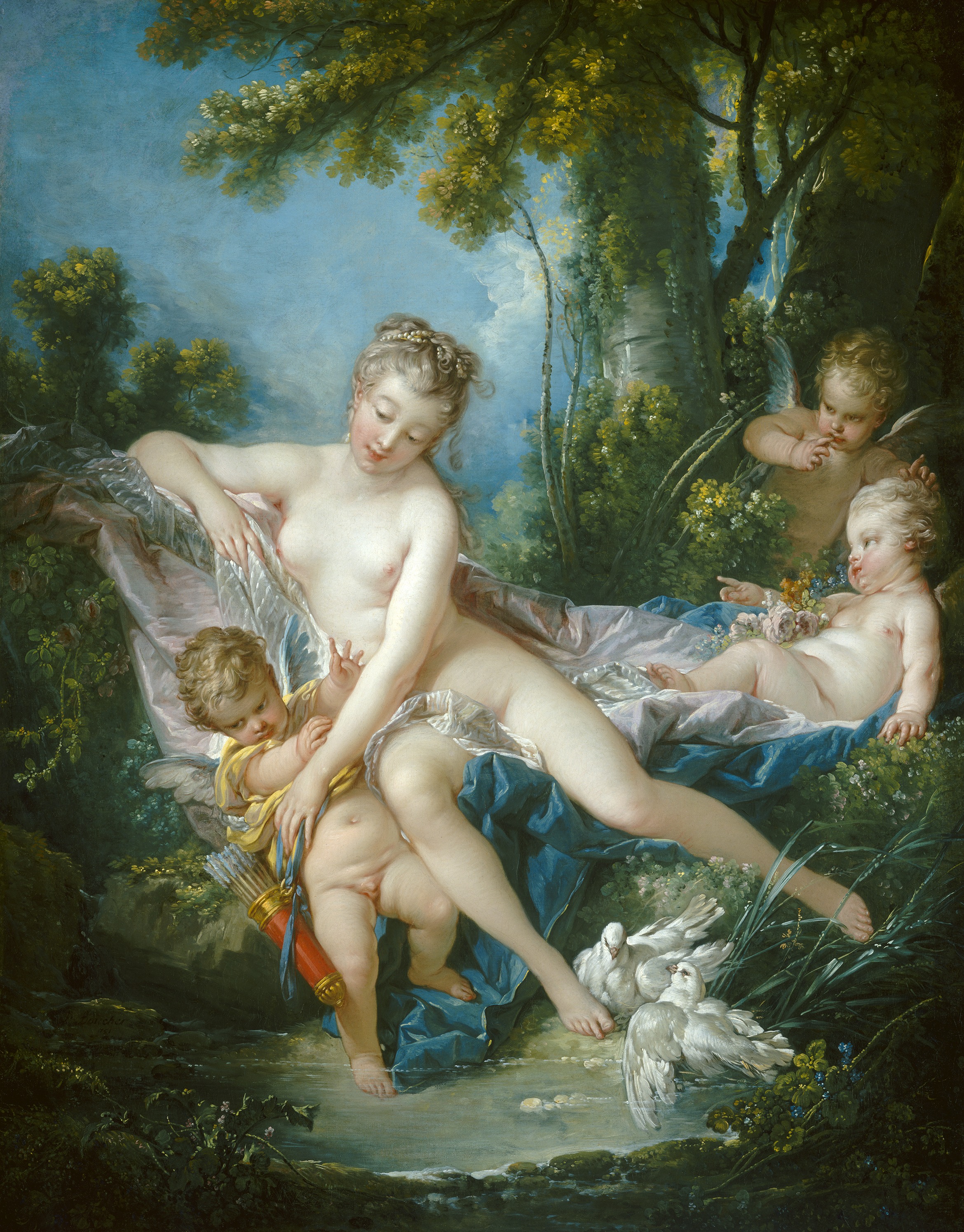
The Bath of Venus, 1751
François Boucher (1703 – 1770)
107 x 84.8 cm
Oil on canvas
National Gallery of Art, Washington, D.C.
Blue jacket is the iconic costume in the pictorial representations of the Virgin Mary.
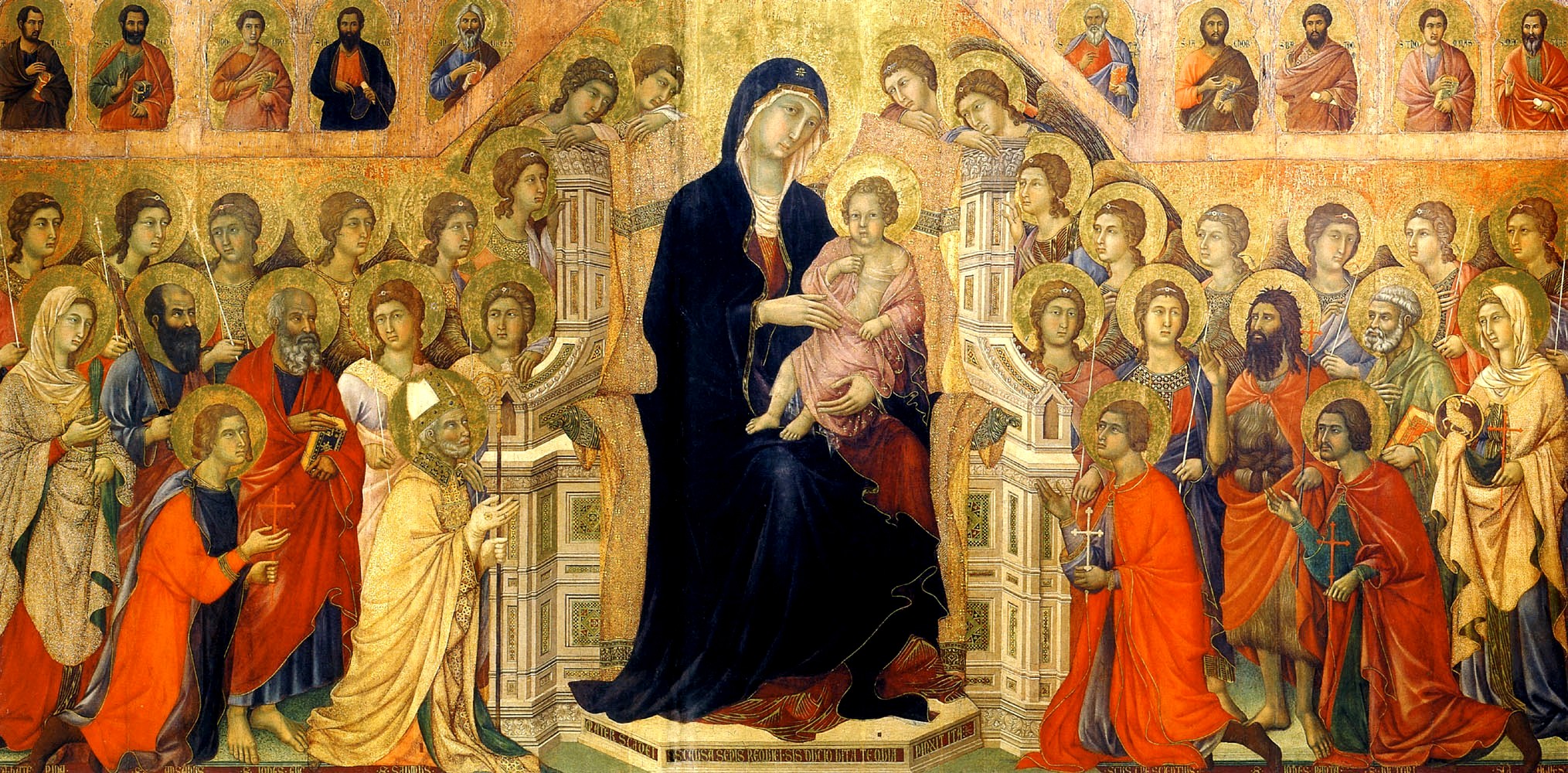
Central panel of the Maestà, 1308 - 1311
Duccio di Buoninsegna (c. 1255 – 1319)
Tempera and gold on wood
213 x 396 cm
Museo dell'Opera Metropolitana del Duomo, Siena
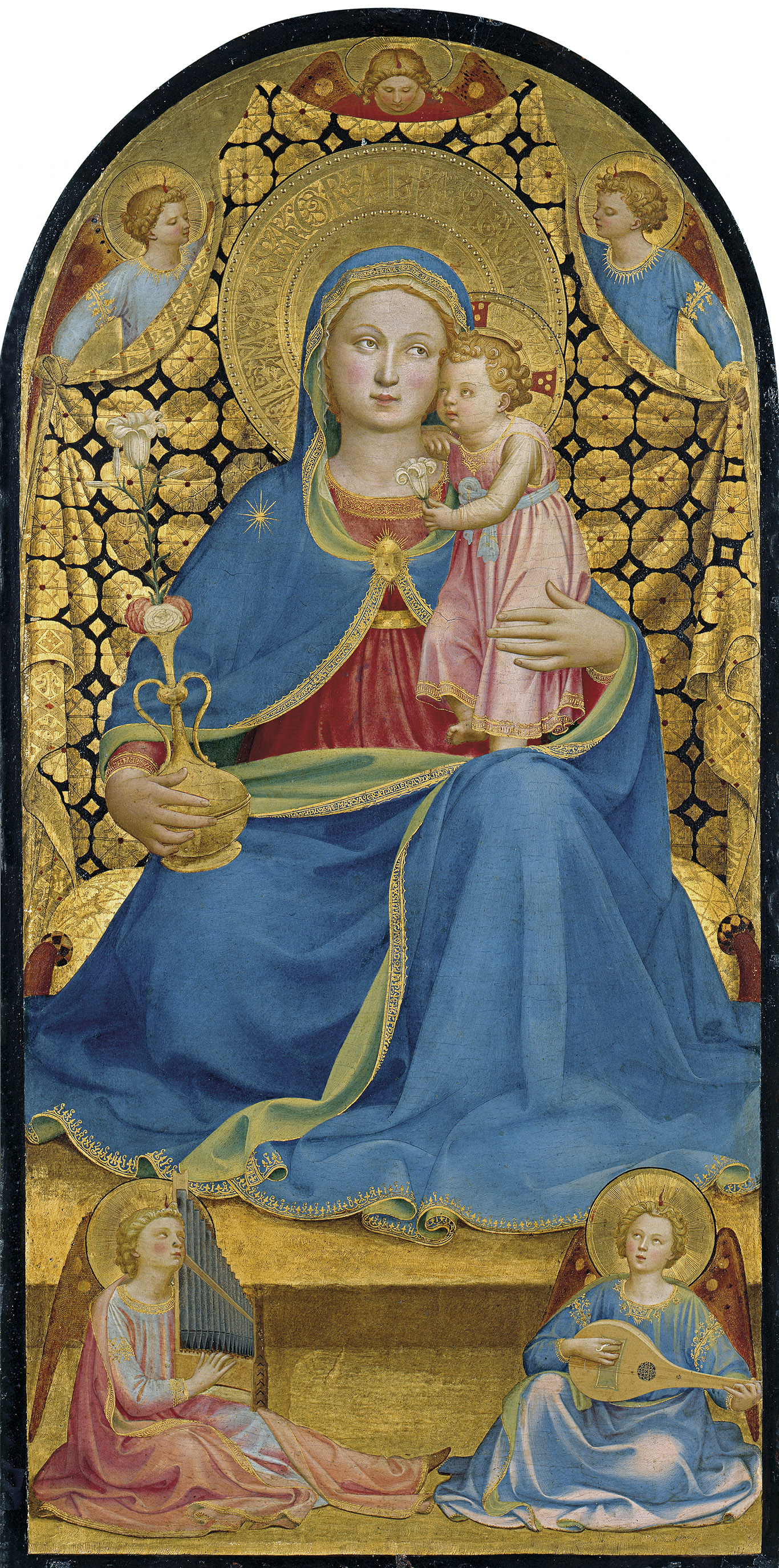
Madonna of Humility, 1433 – 1435
Fra Angelico, (c. 1395 – 1455)
Tempera on wood
147 × 91 cm
National Art Museum of Catalonia, Barcelona
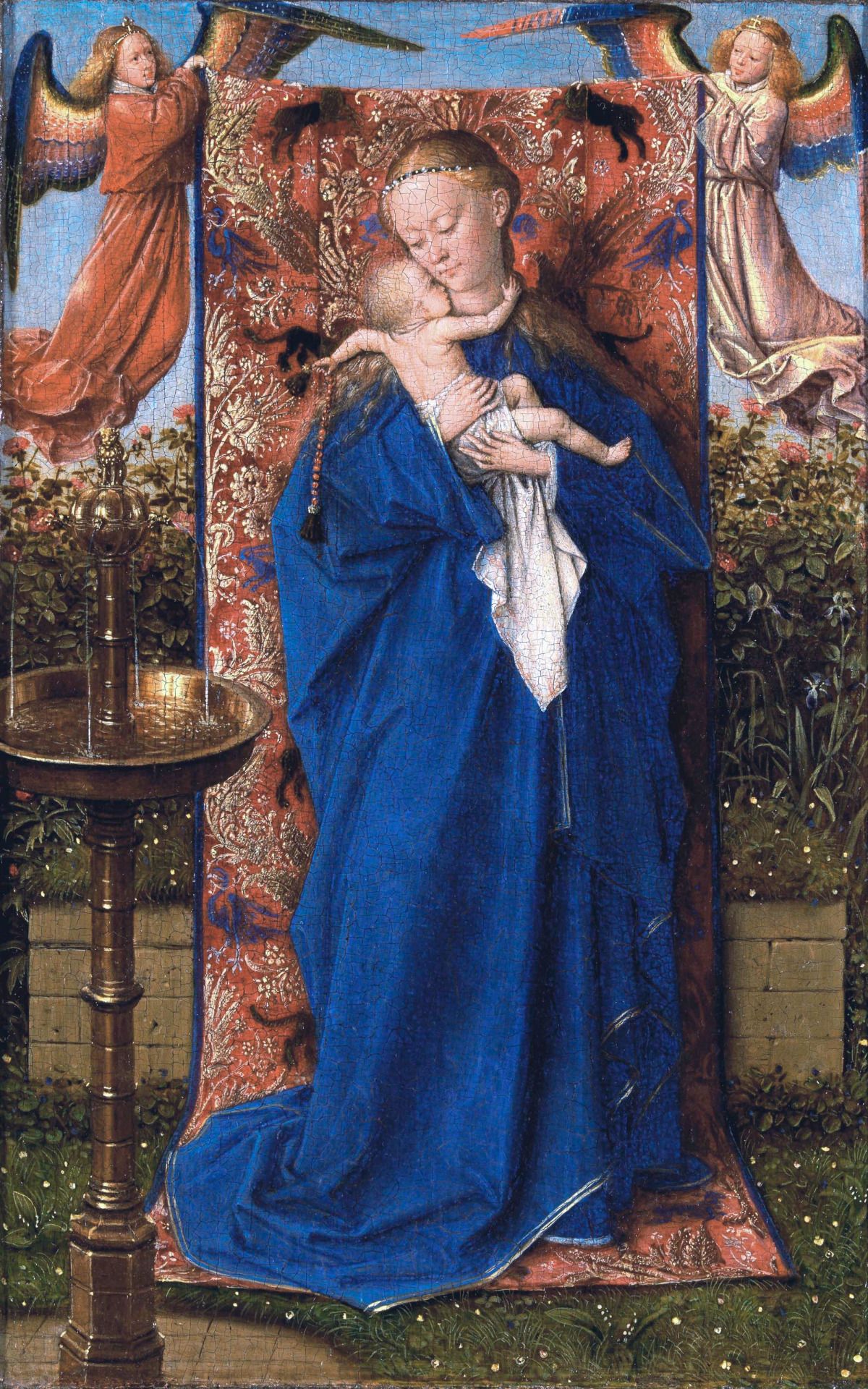
The Virgin and Child by a Fountain, c. 1440
Workshop of Jan van Eyck
Oil on panel
21.27 × 17.15 cm
Private collection
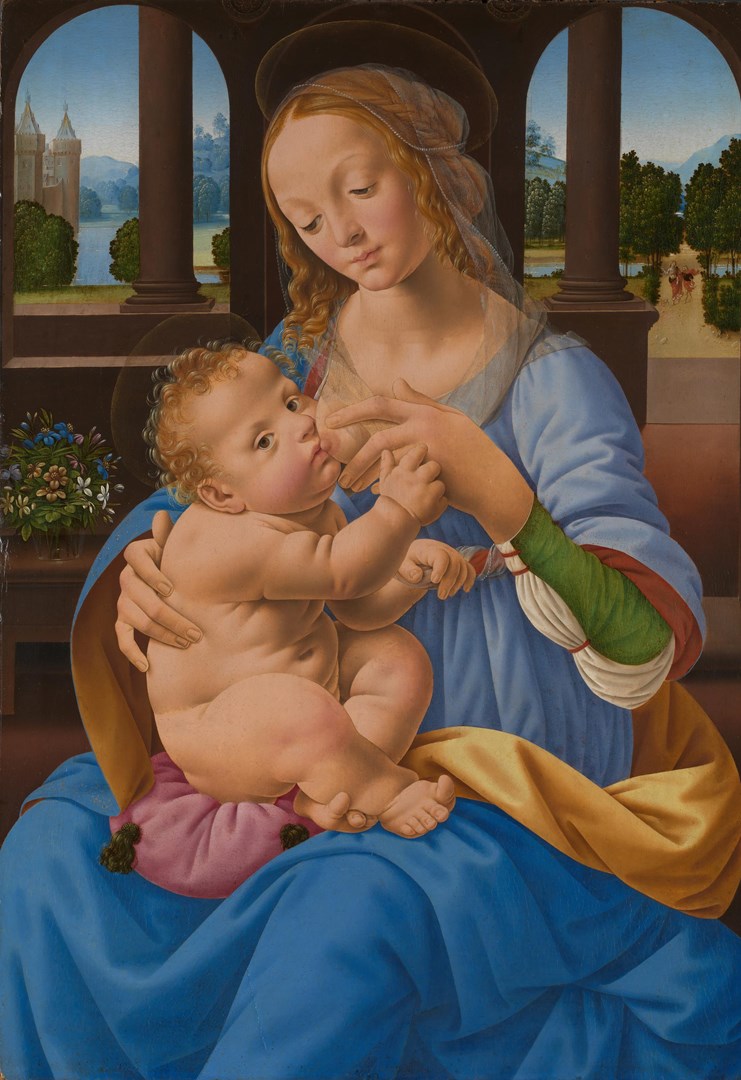
The Virgin and Child, 1480 - 1485
Lorenzo di Credi, (c. 1458 - 1537)
Oil on wood
71.1 x 49.5 cm
National Gallery, London
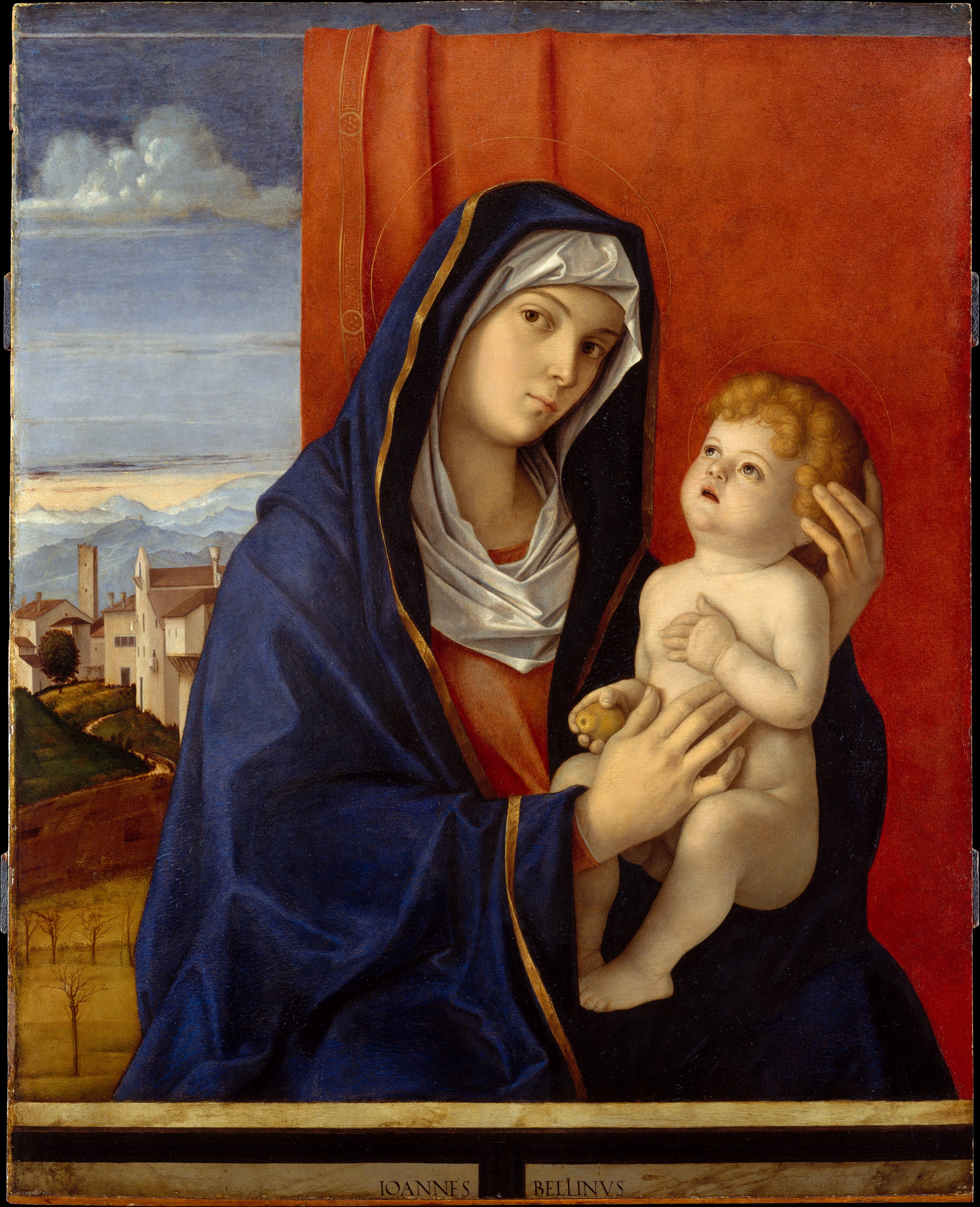
Madonna and Child, 1480s
Giovanni Bellini (c. 1430 - 1516)
Oil on wood
88.9 x 71.1 cm
The Metropolitan Museum of Art, New York
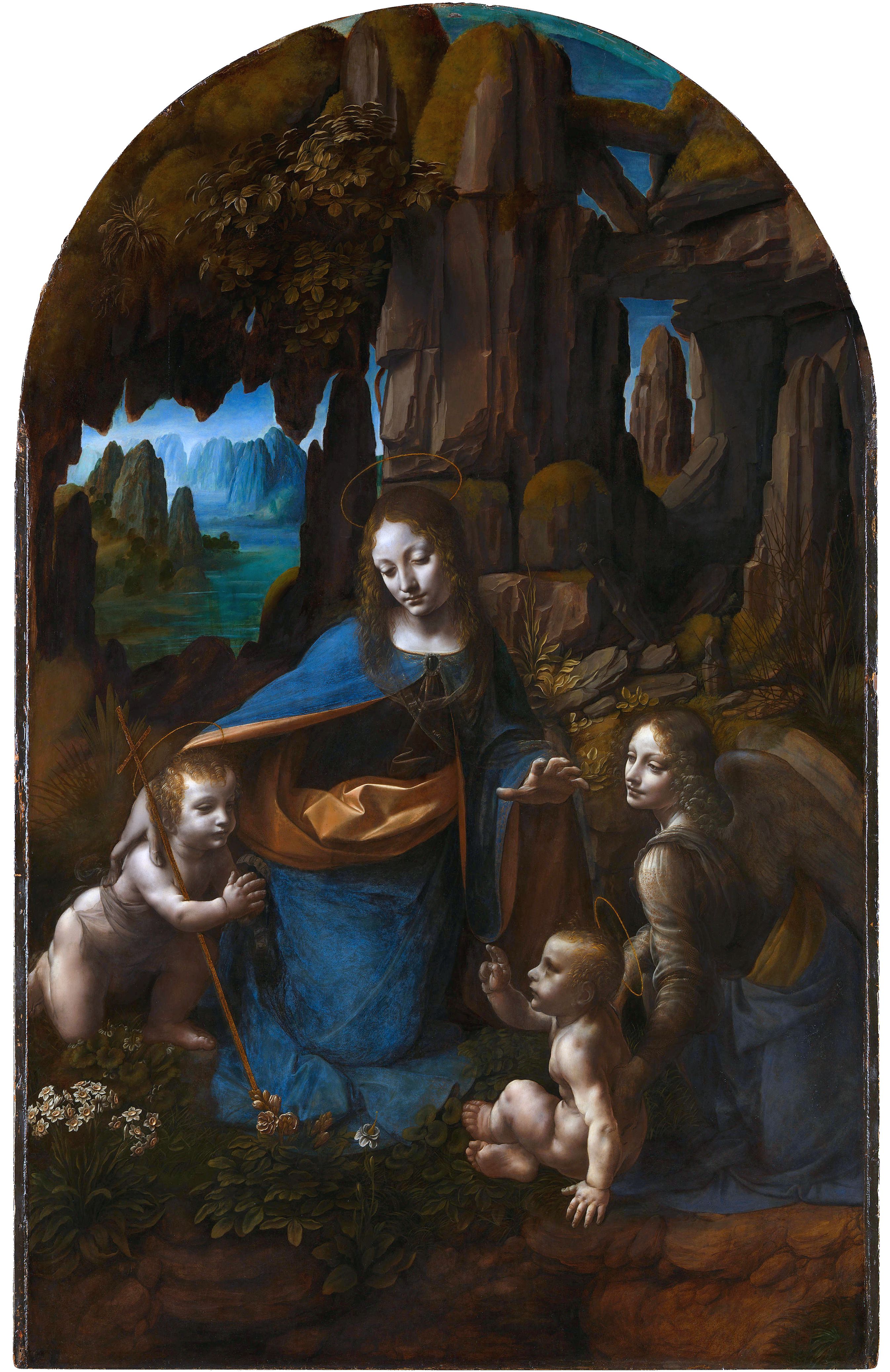
Virgin of the Rocks, 1495 – 1508
Leonardo da Vinci (1452 - 1519) and other(s)
Oil on panel
189.5 × 120 cm
National Gallery, London
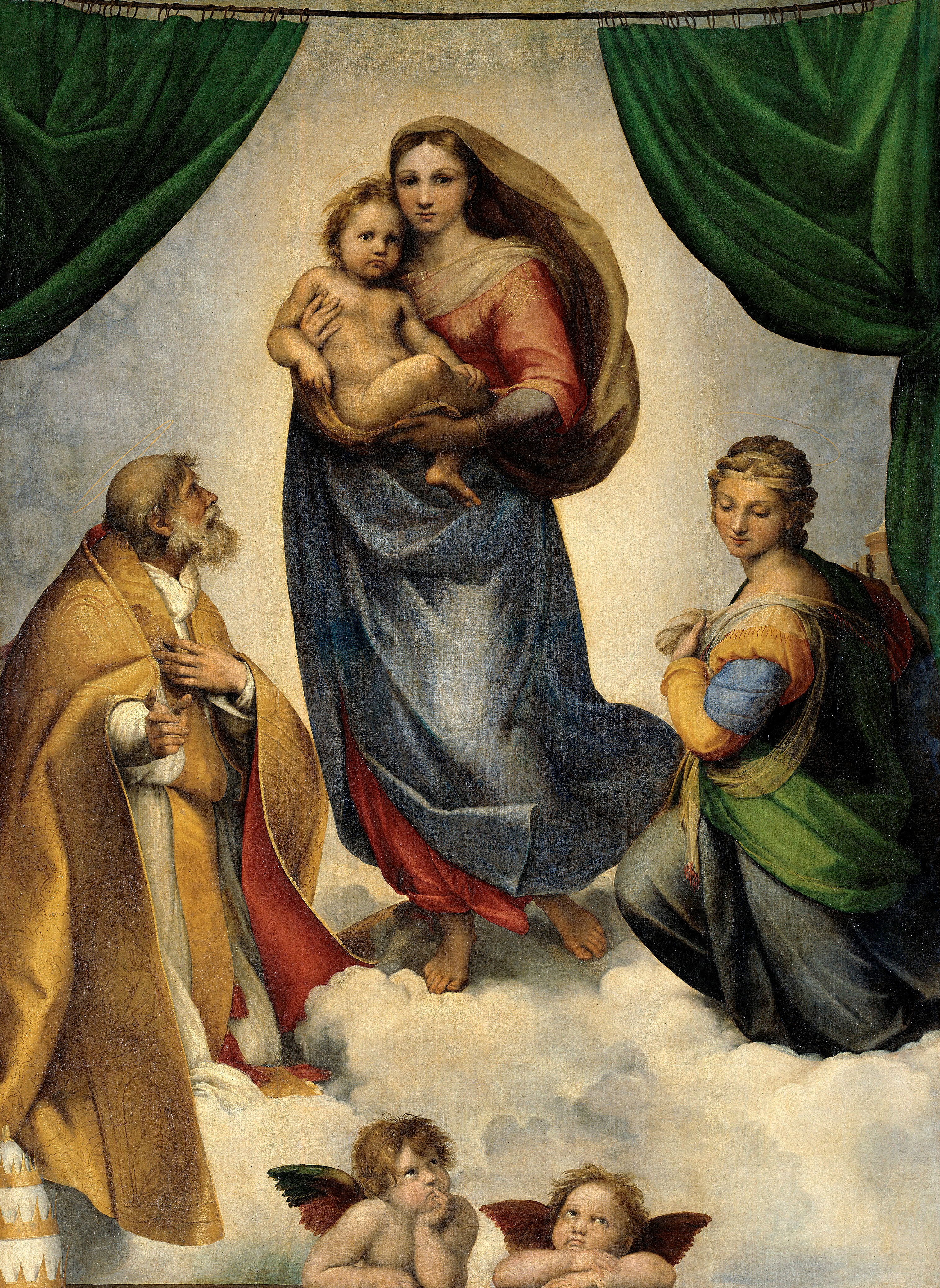
The Sistine Madonna, 1512 - 1513
Raphael (1483-1520)
201 x 269.5 cm
Oil on canvas
Old Masters Picture Gallery, Dresden
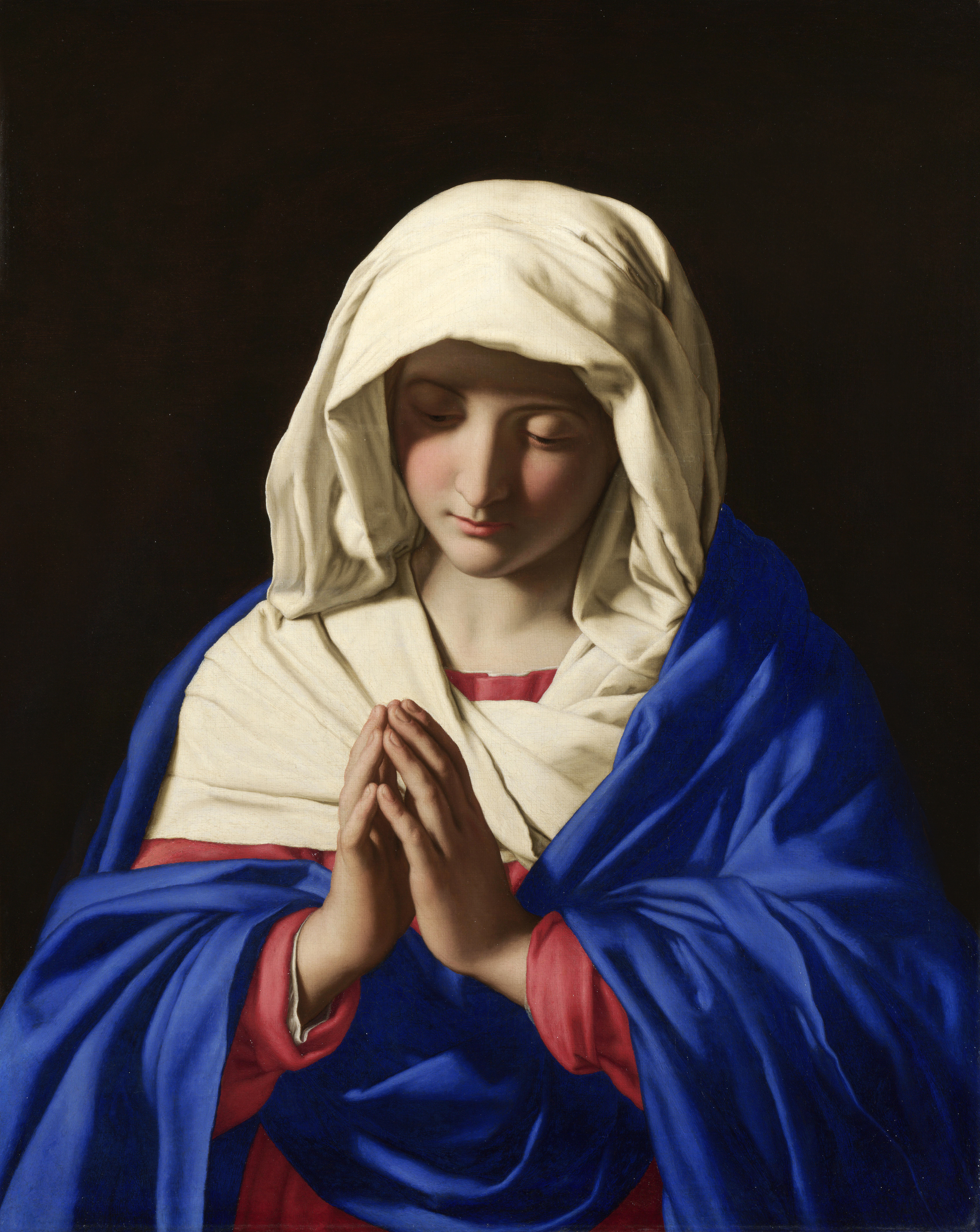
The Virgin in Prayer, 1640 - 1650
Sassoferrato (1609 - 1685)
Oil on canvas
73 x 57.7 cm
National Gallery, London
Deconstruction
Introduction
- With its emphasis on de-centralization, Deconstructionism maintains that artworks are open to individual interpretations.
- Viewers are encouraged to raise doubts about the one intended interpretation of visual text, while alternative interpretations of an open text embrace the diversity of artistic meanings.
Application
- The woman is holding a balance in her right hand (an emblem of justice), while supporting herself with her left hand placed on the table.
- In Christian culture, left hand represents the evil. Meanwhile, the table counterpointing the painting of the Last Judgment on the wall represents the worldliness and the evil world.
- Does it indicate that justice, the symbolic meaning of the scales, also depends on the support of the worldliness, in order that equilibrium of the scales could be maintained?
- In the painting, light source represents God, and the balance is a tool used in everyday life, often giving convincing and accurate weighing results. Is there any hidden truth communicated by the painting?
- The mortal men being condemned in the Last Judgment are incidentally blocked by the head and shoulder of the young woman in the front. Does it indicate that Vermeer does not want us to see those men descending into hell?
- Examine the small hole and the nail at the top of the painting in detail. What do they signify? Does the depiction of these two details serve to form a well-arranged composition?
- Suppose there was a cross hanging on the nail, while another piece of Vermeer’s works on another nail, which was later removed and left a small hole on the wall. Can you think of the reasons why these details are depicted in the work?
- In Dutch, “hol” means both “hole” and “hollow”. Do you think that vanity of human life is the theme communicated by Vermeer’s work?
The woman is holding a balance in her right hand, an emblem of justice, while supporting herself with her left hand placed on the table.

In Christian culture, left hand is emblematic of the evil; meanwhile, the jewellery on the table represents the worldliness.

The mortal men condemned in the Last Judgment are blocked by the head and shoulder of the young woman in the front.

Examine the small hole and the nail at the top of the painting in detail. What does the nail hole signify?

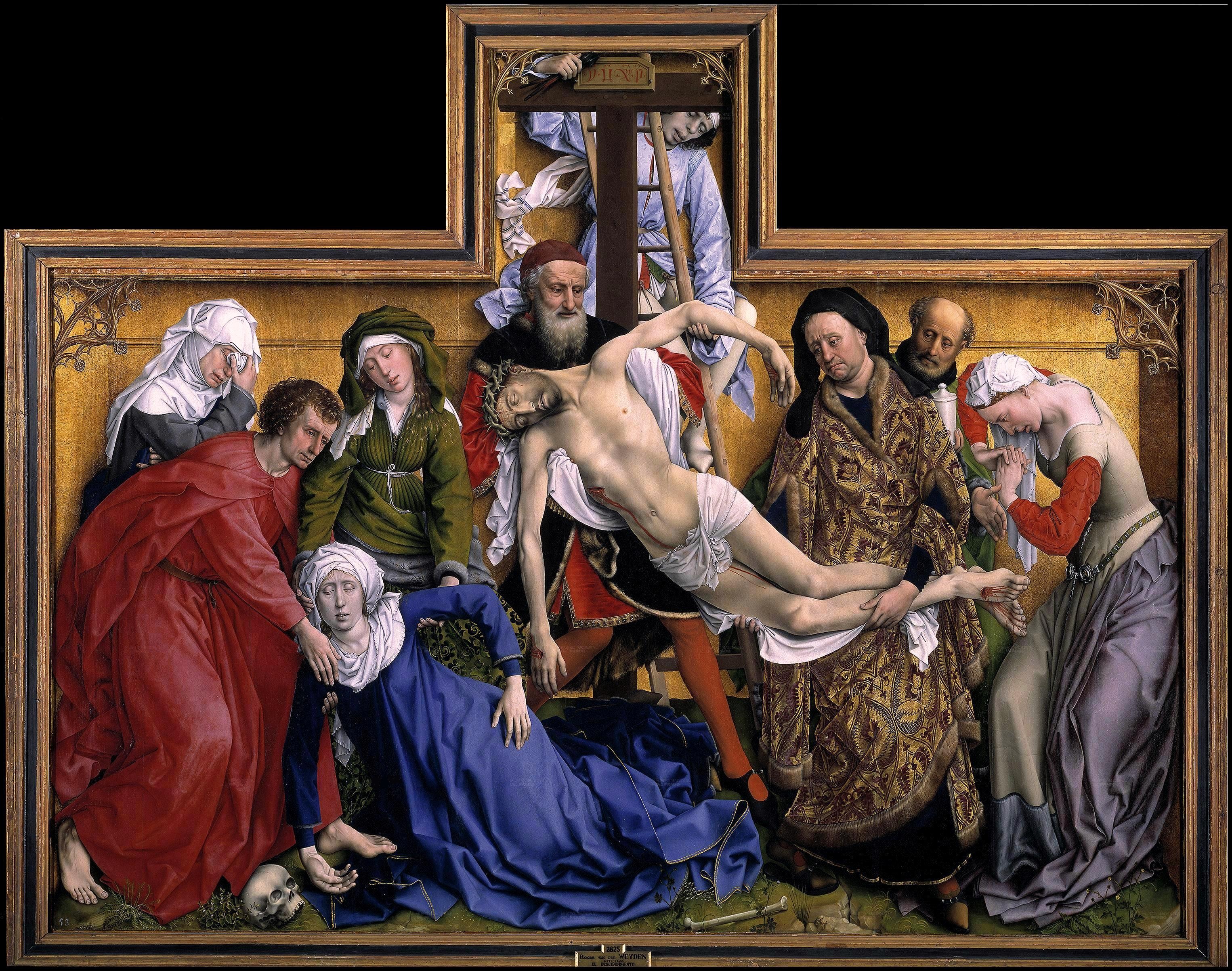
The Descent from the Cross, c. 1435
Rogier van der Weyden (c. 1399/1400 – 1464)
Oil on panel
220 x 262 cm
Museo del Prado, Madrid
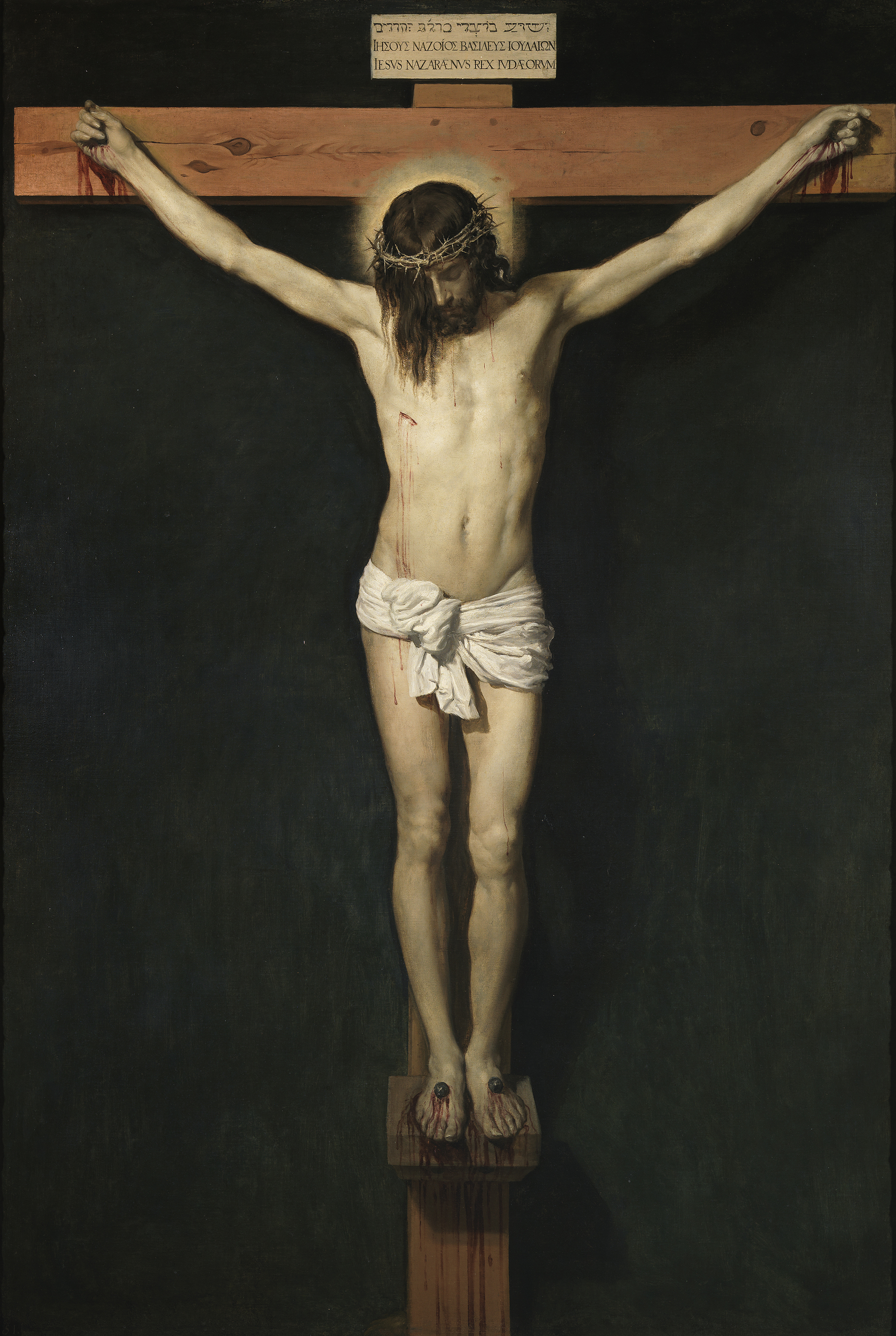
Christ Crucified, 1632
Diego Velázquez (1599 - 1660)
Oil on canvas
249 × 170 cm
Museo del Prado, Madrid
